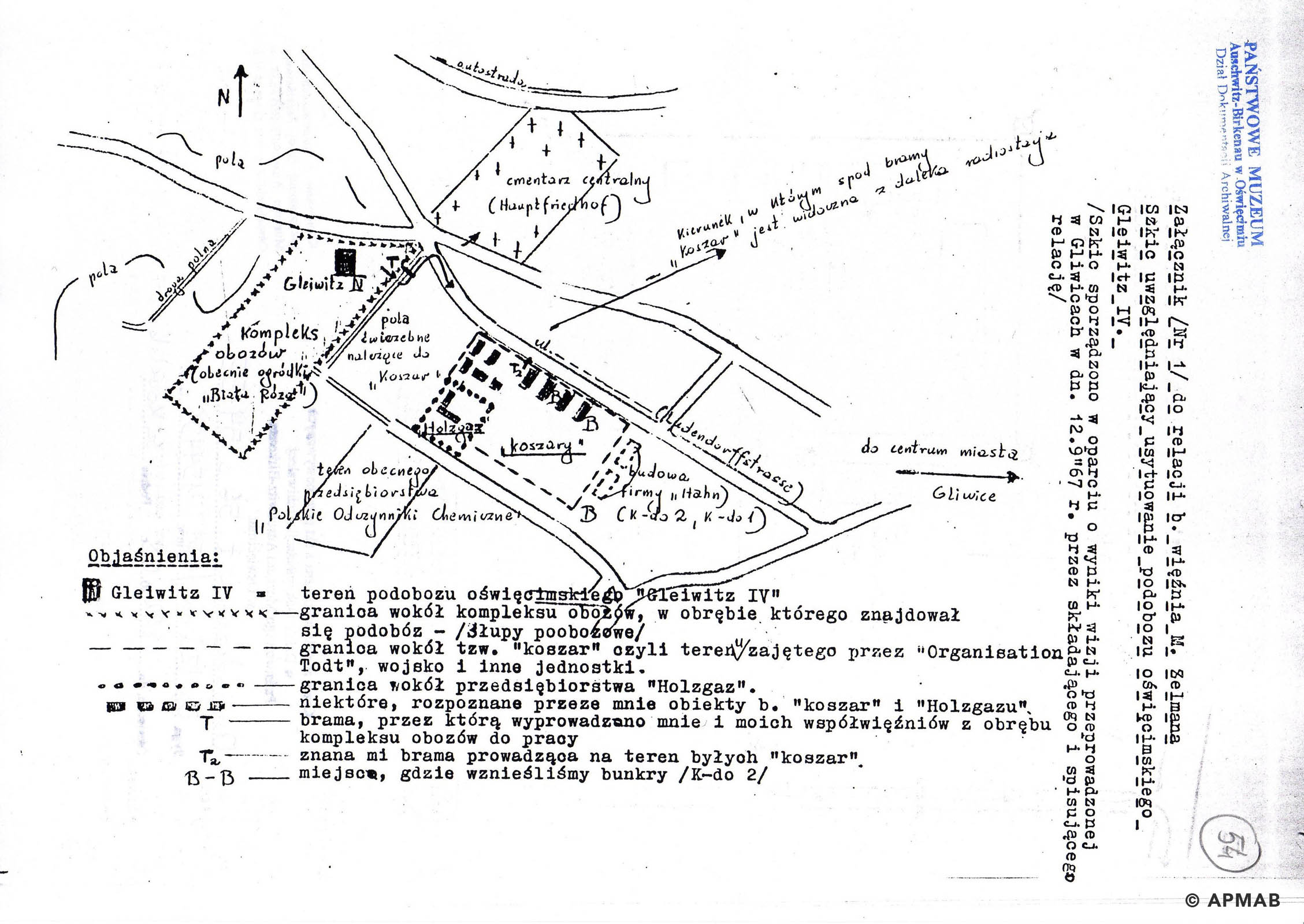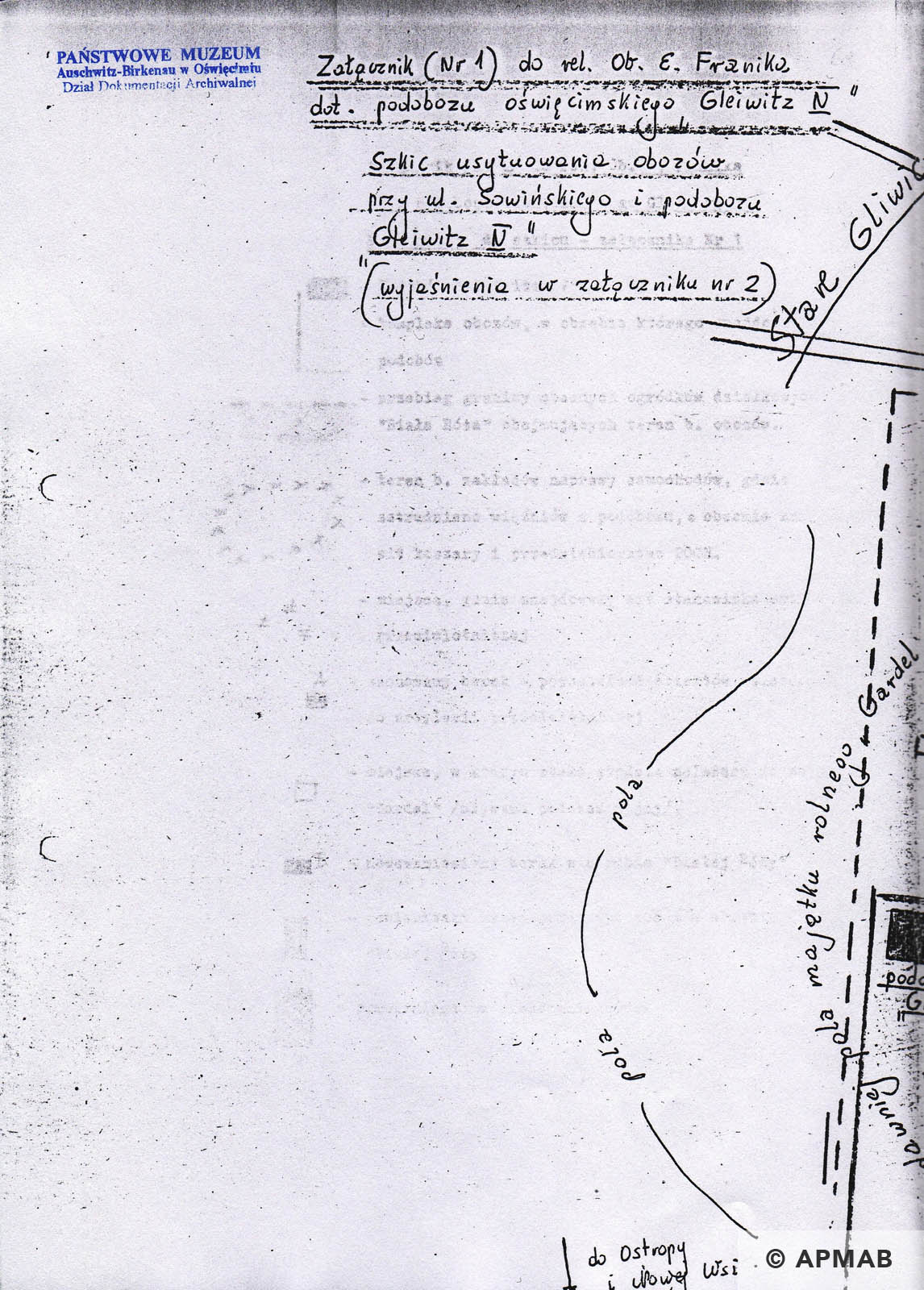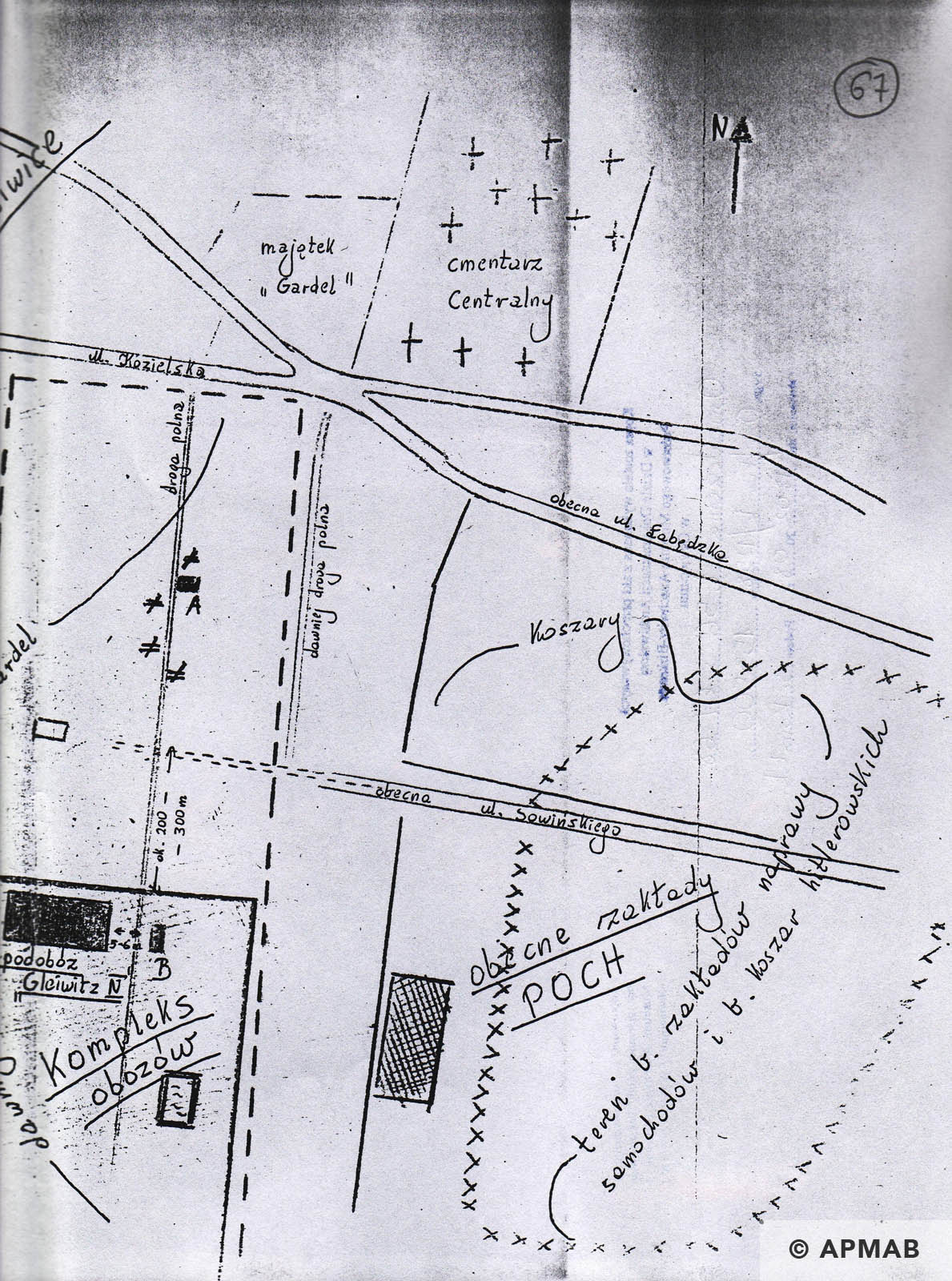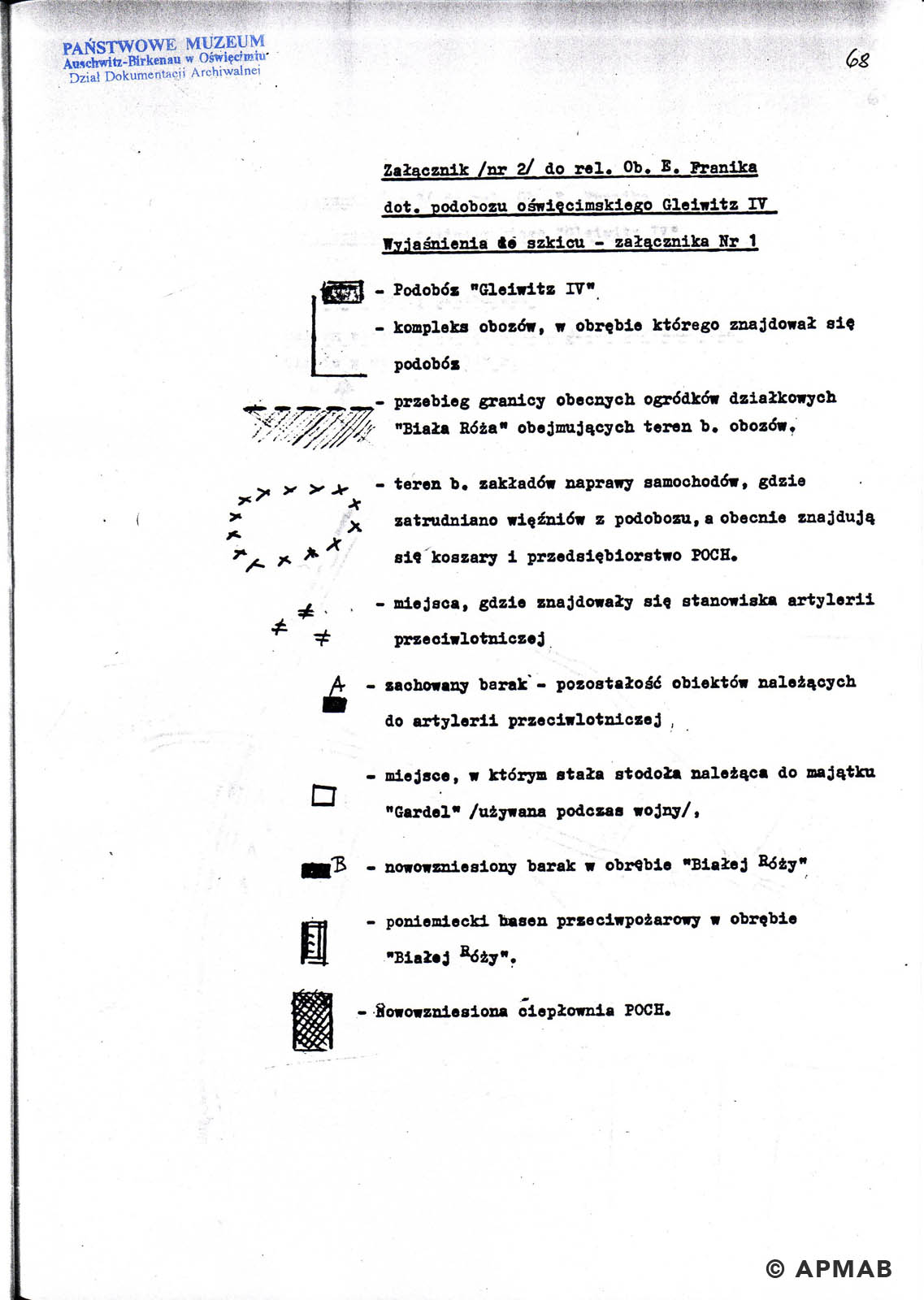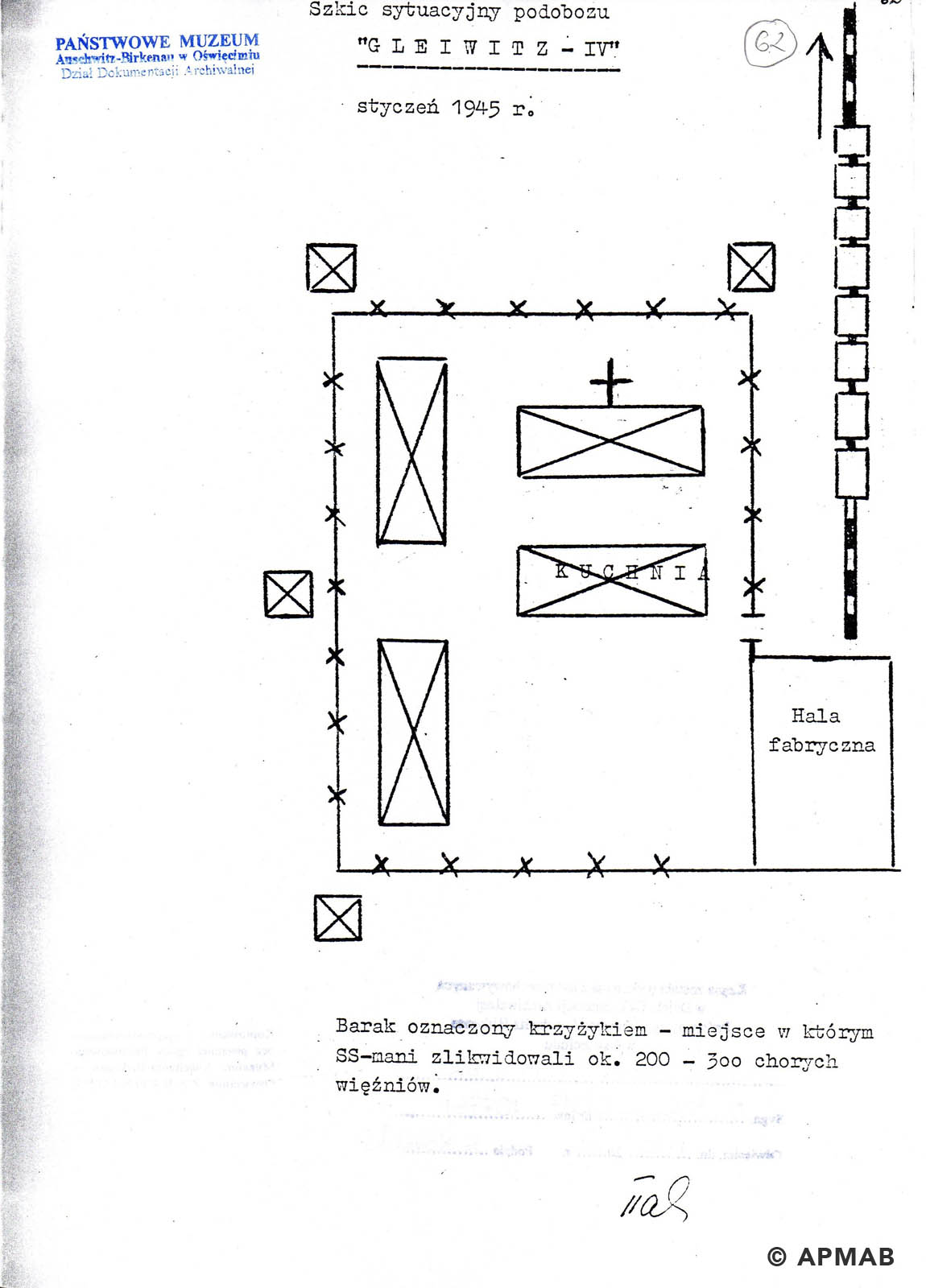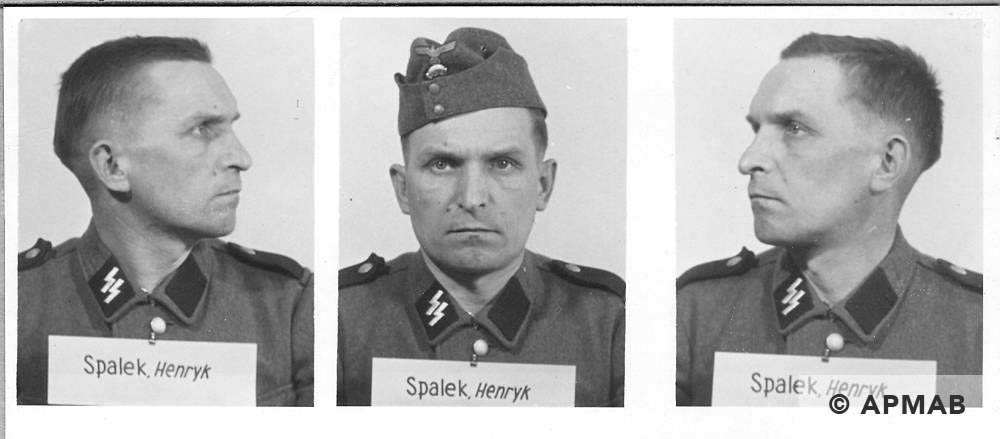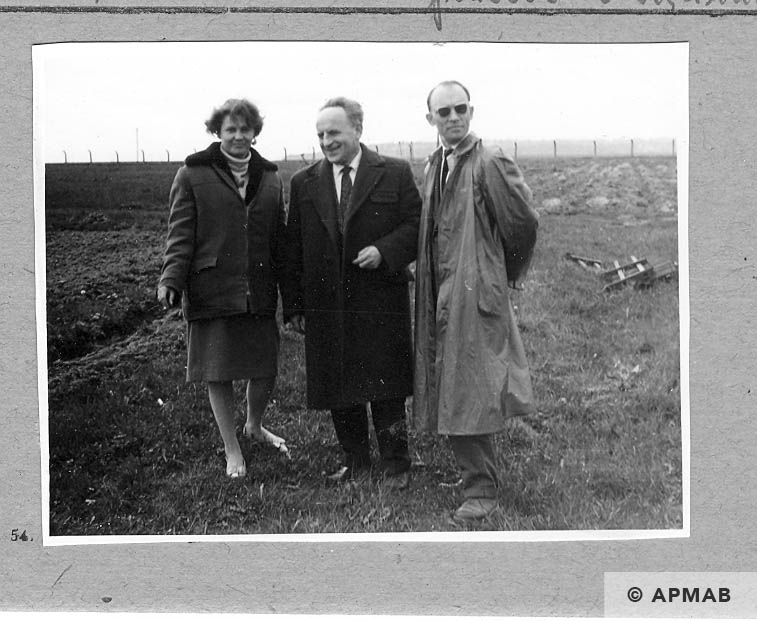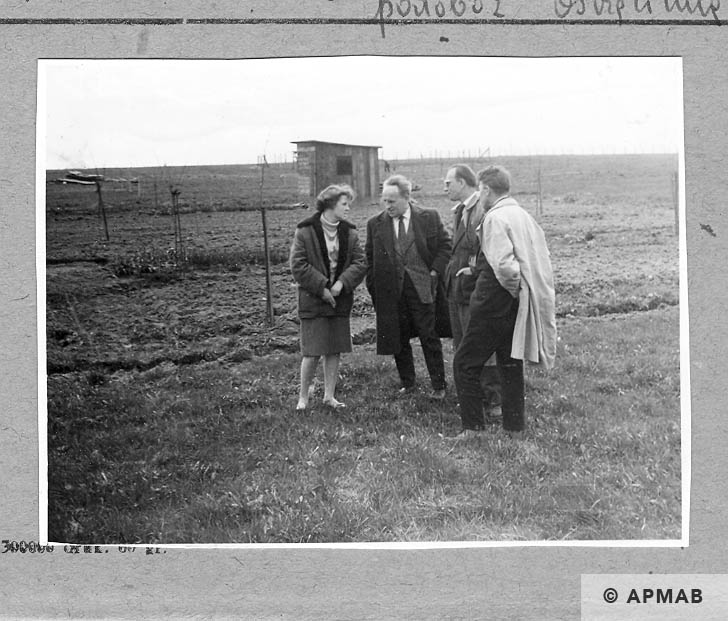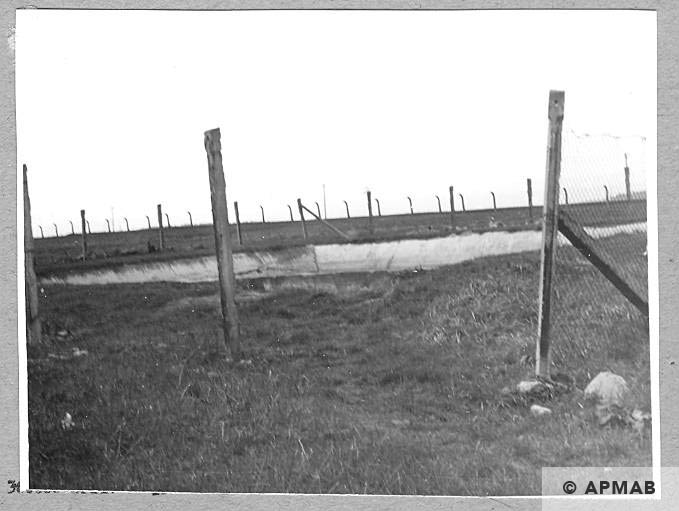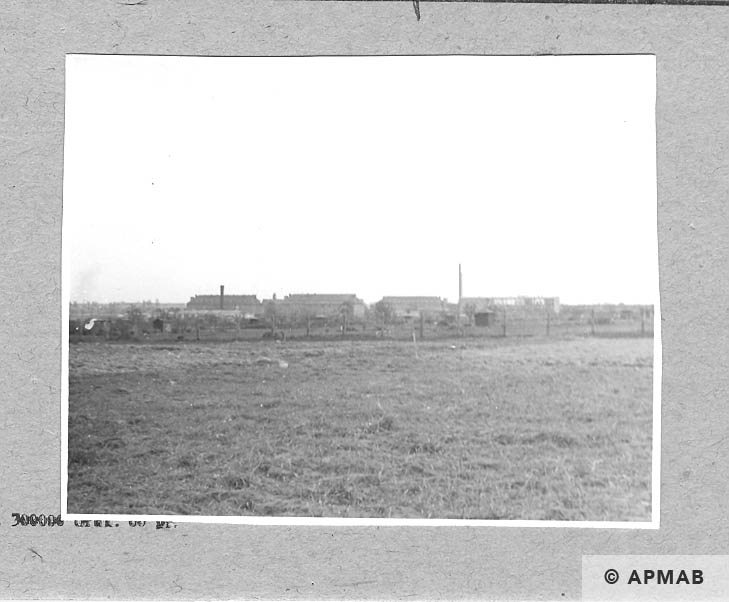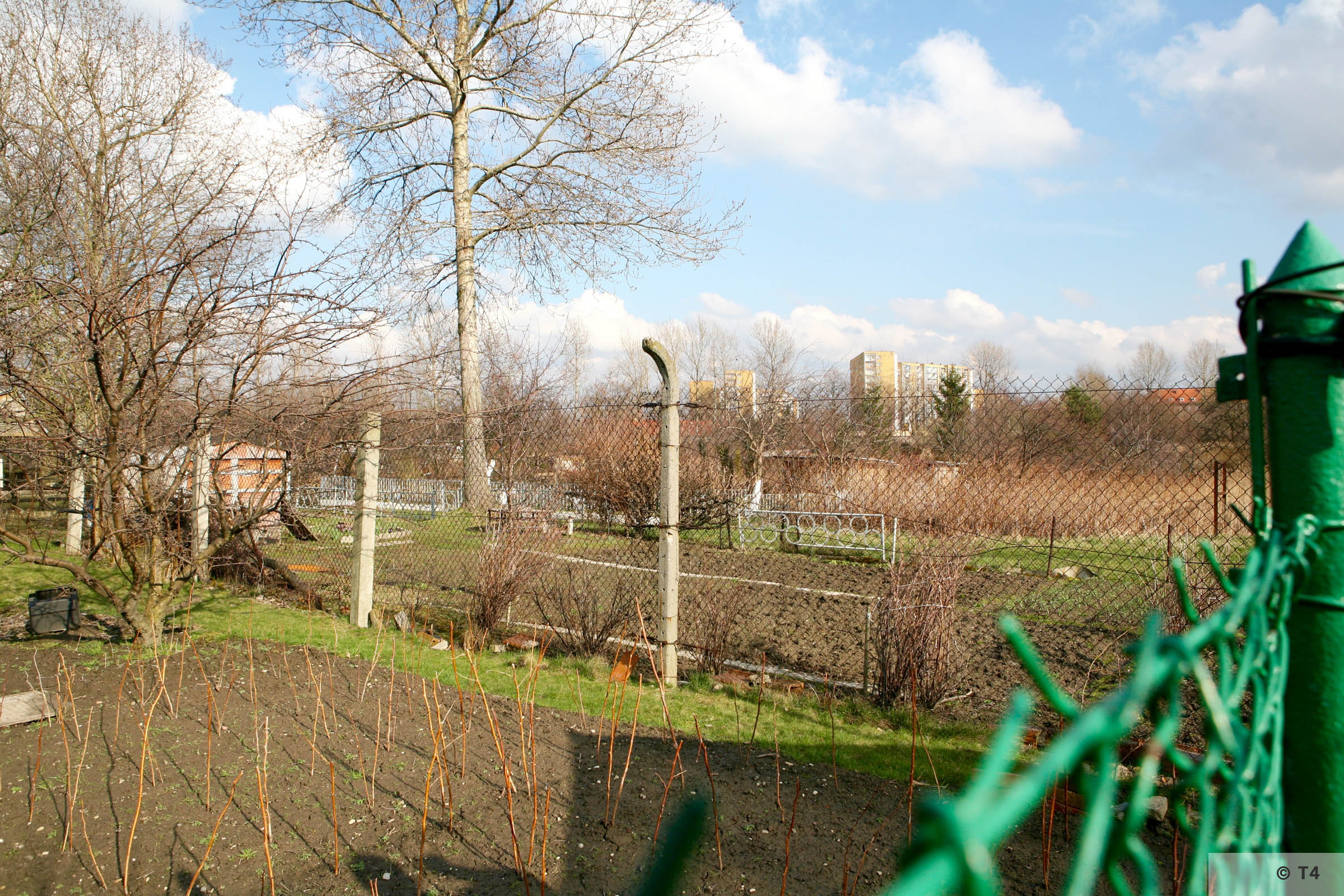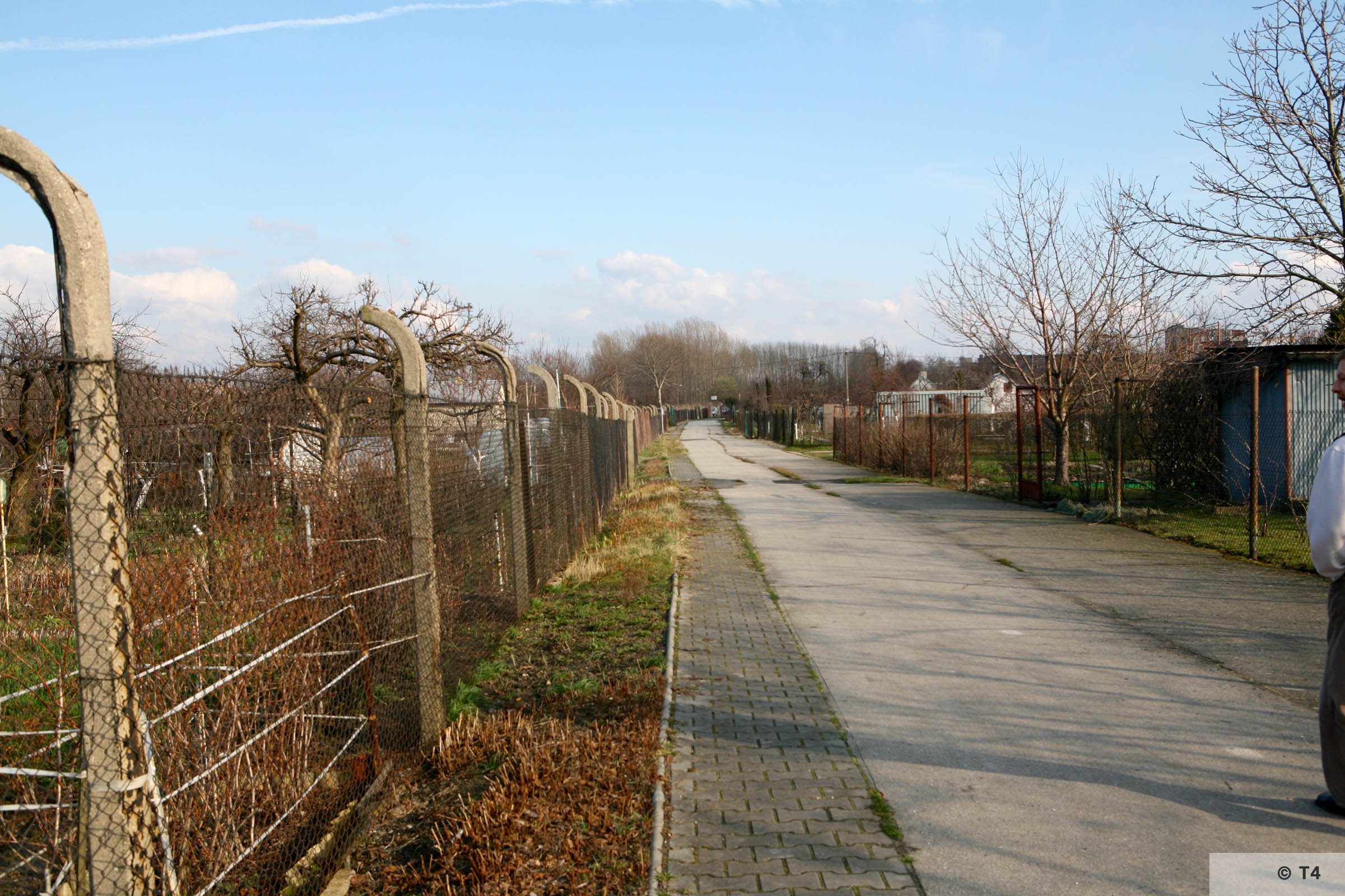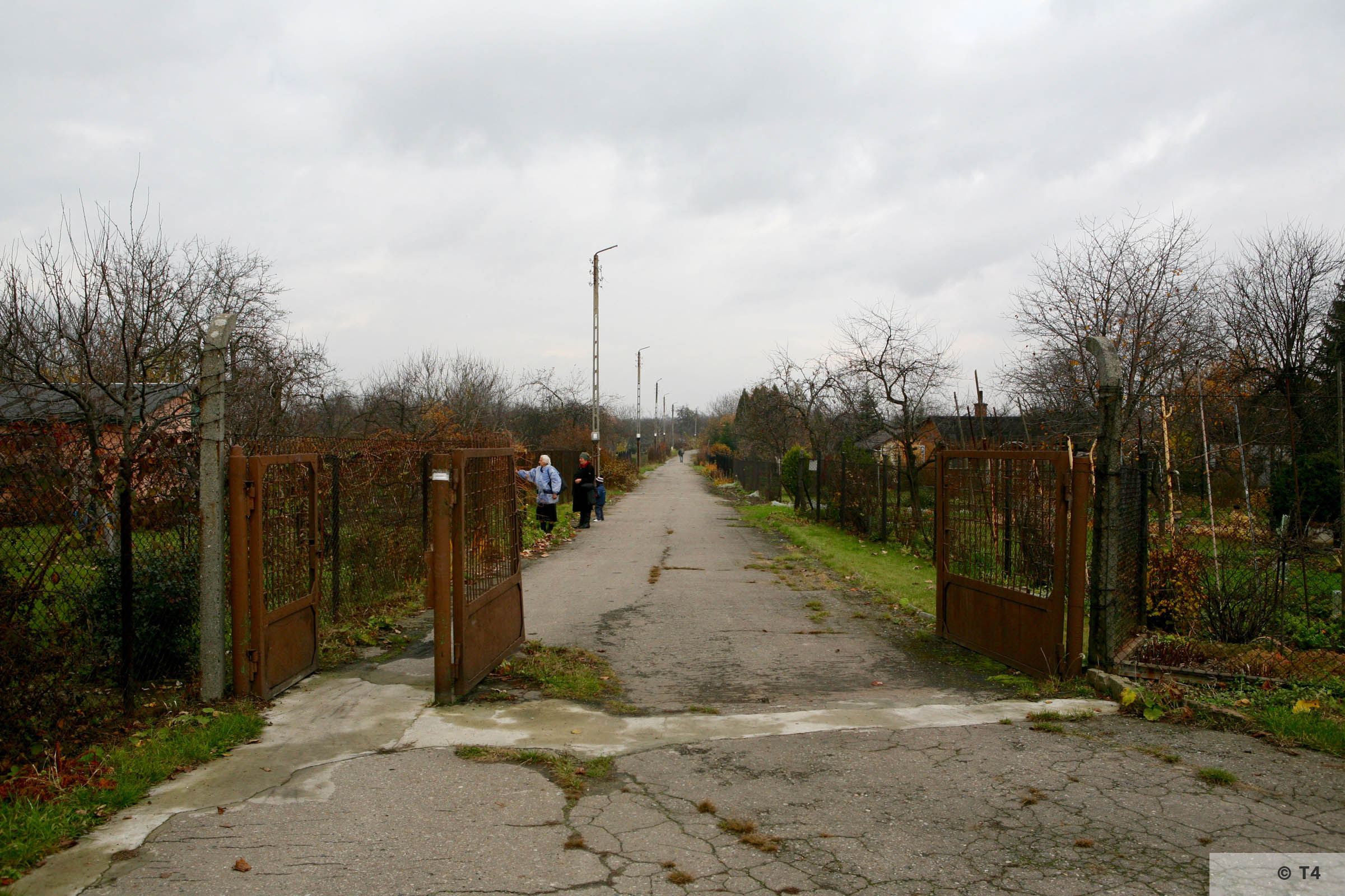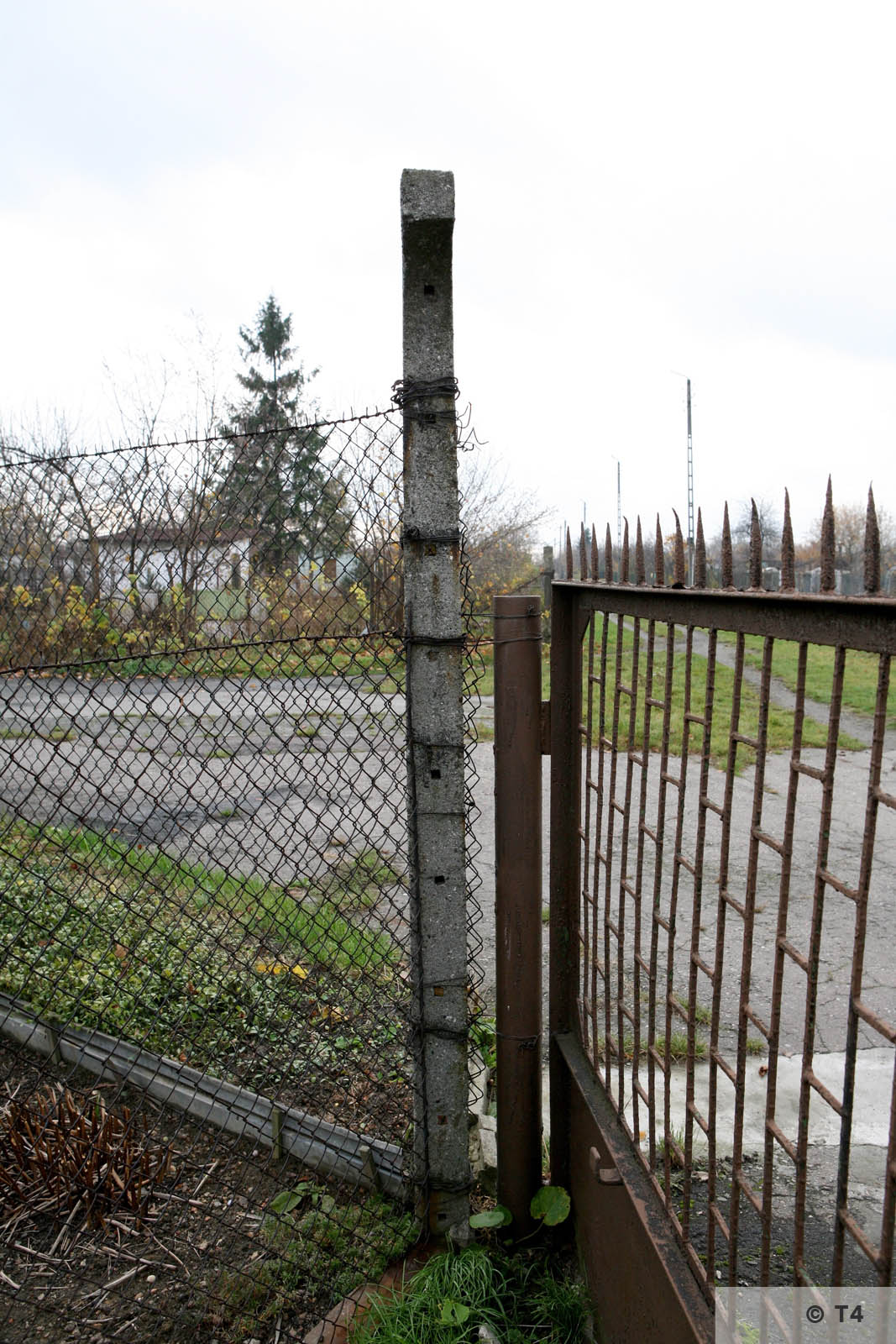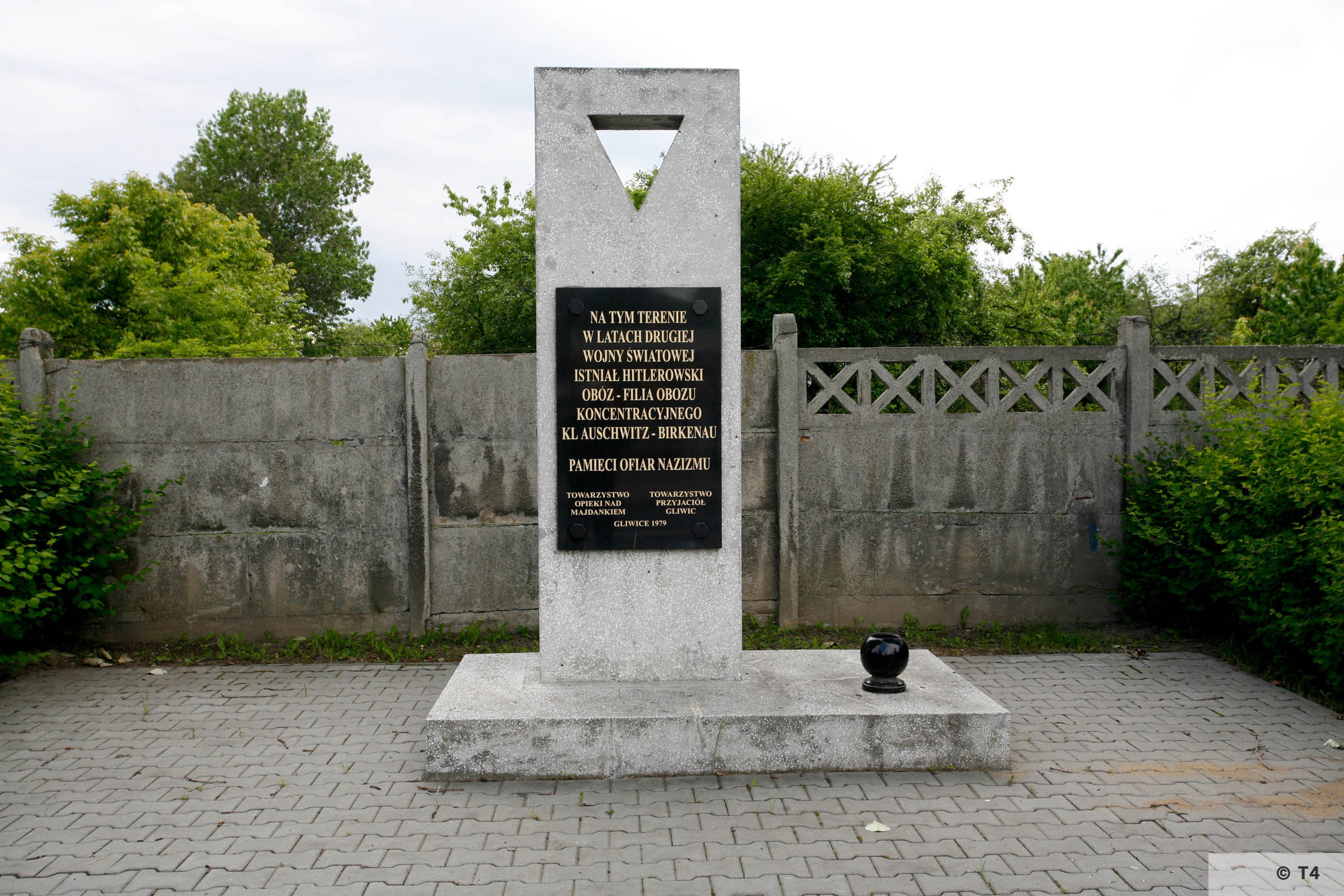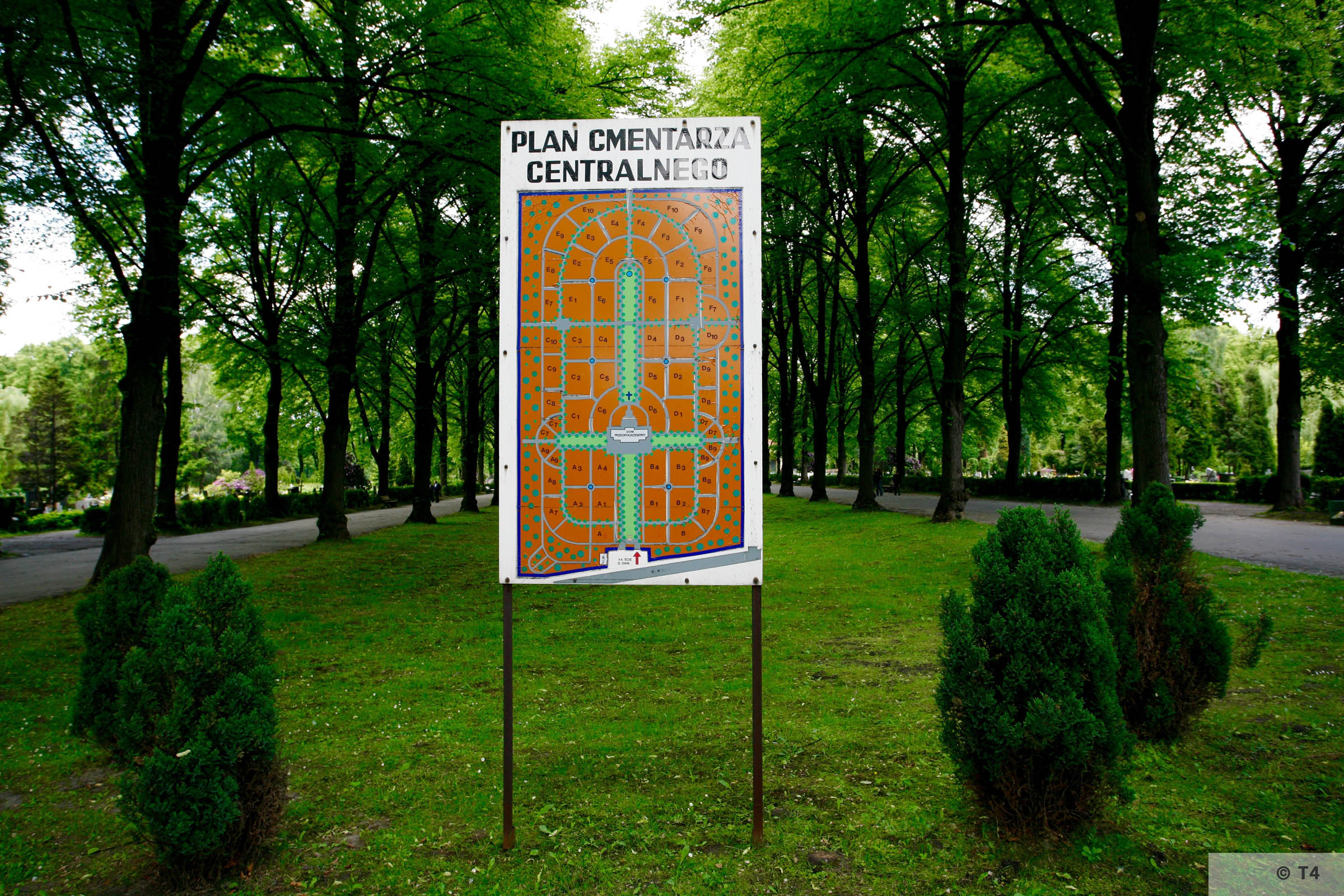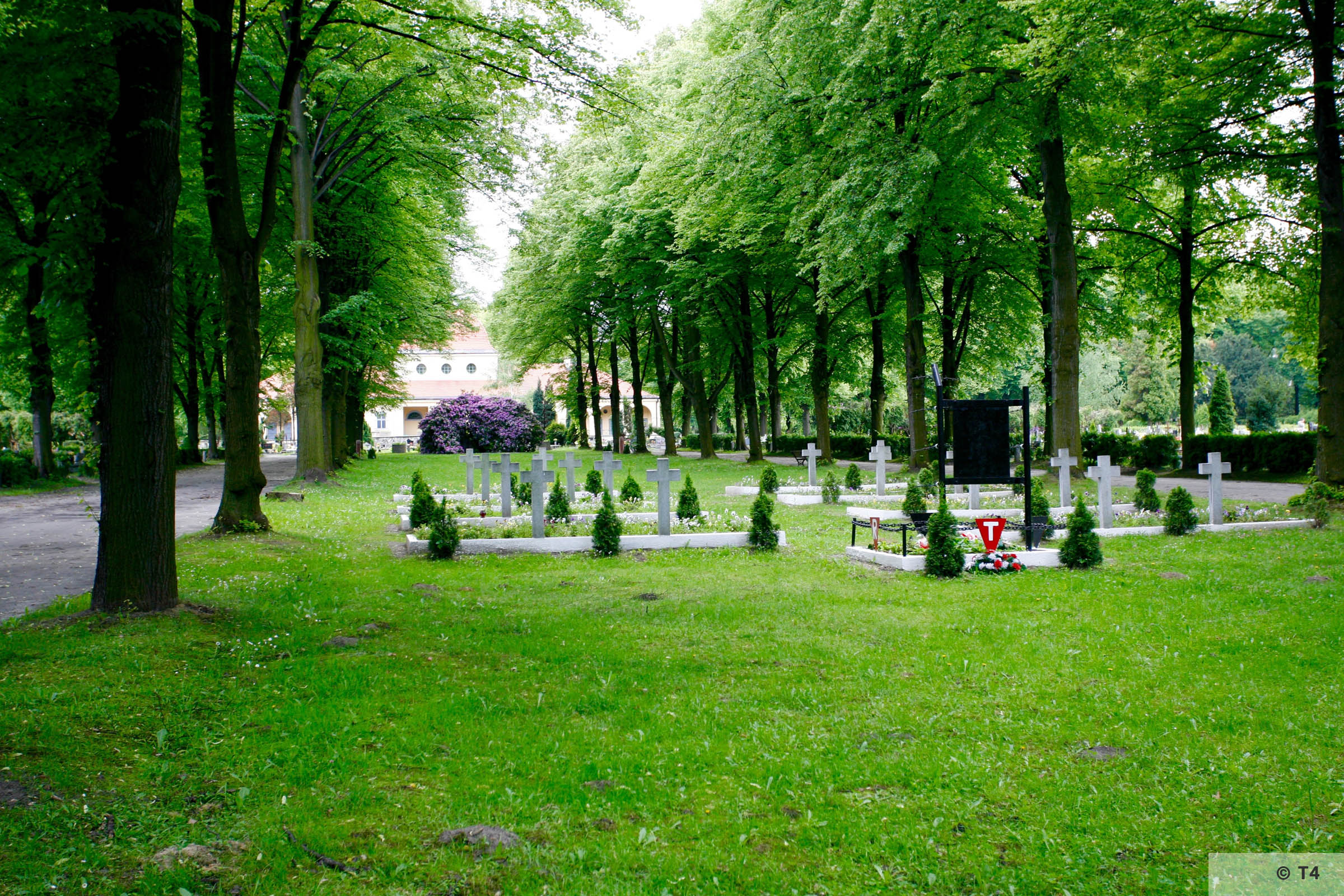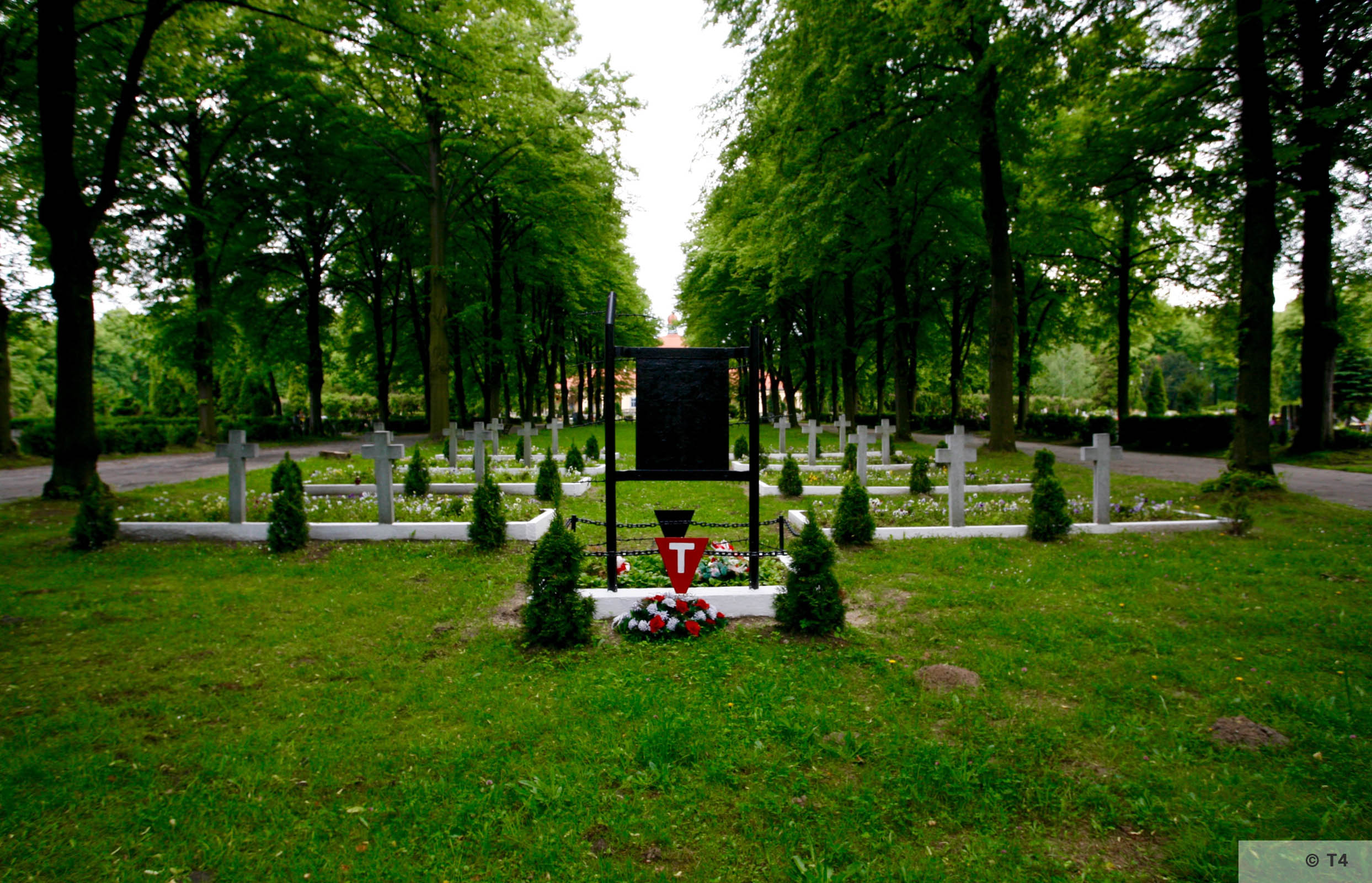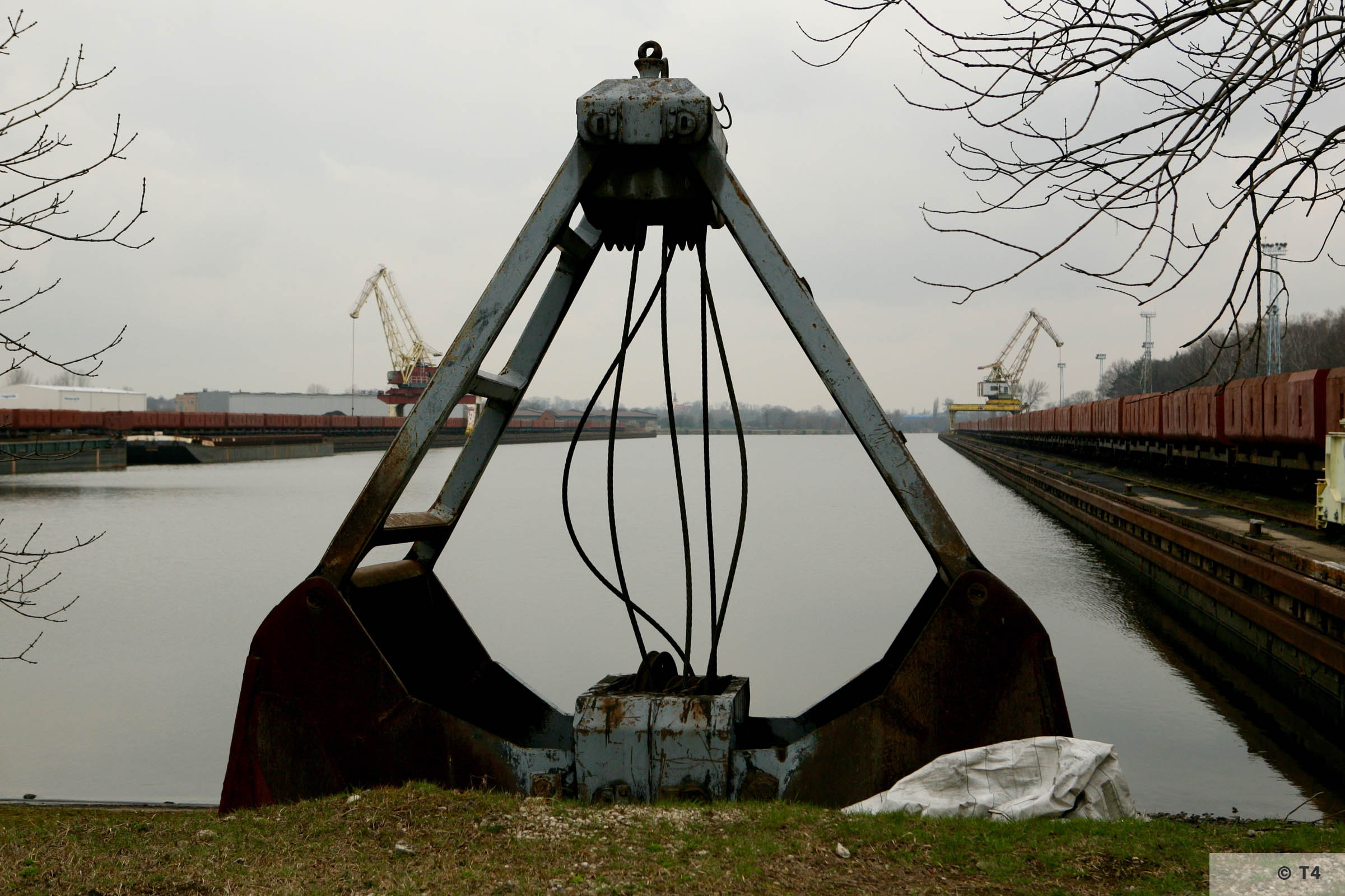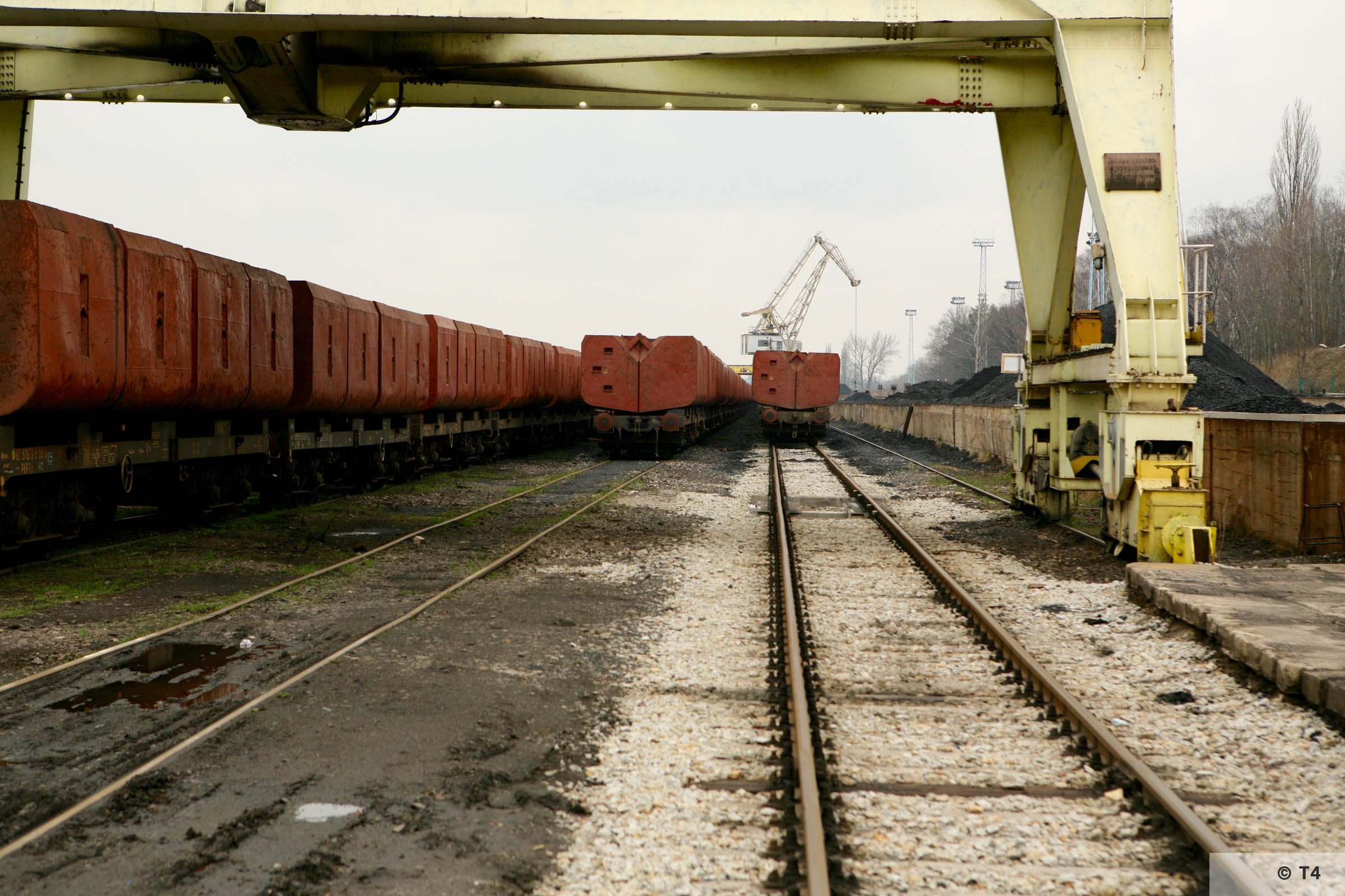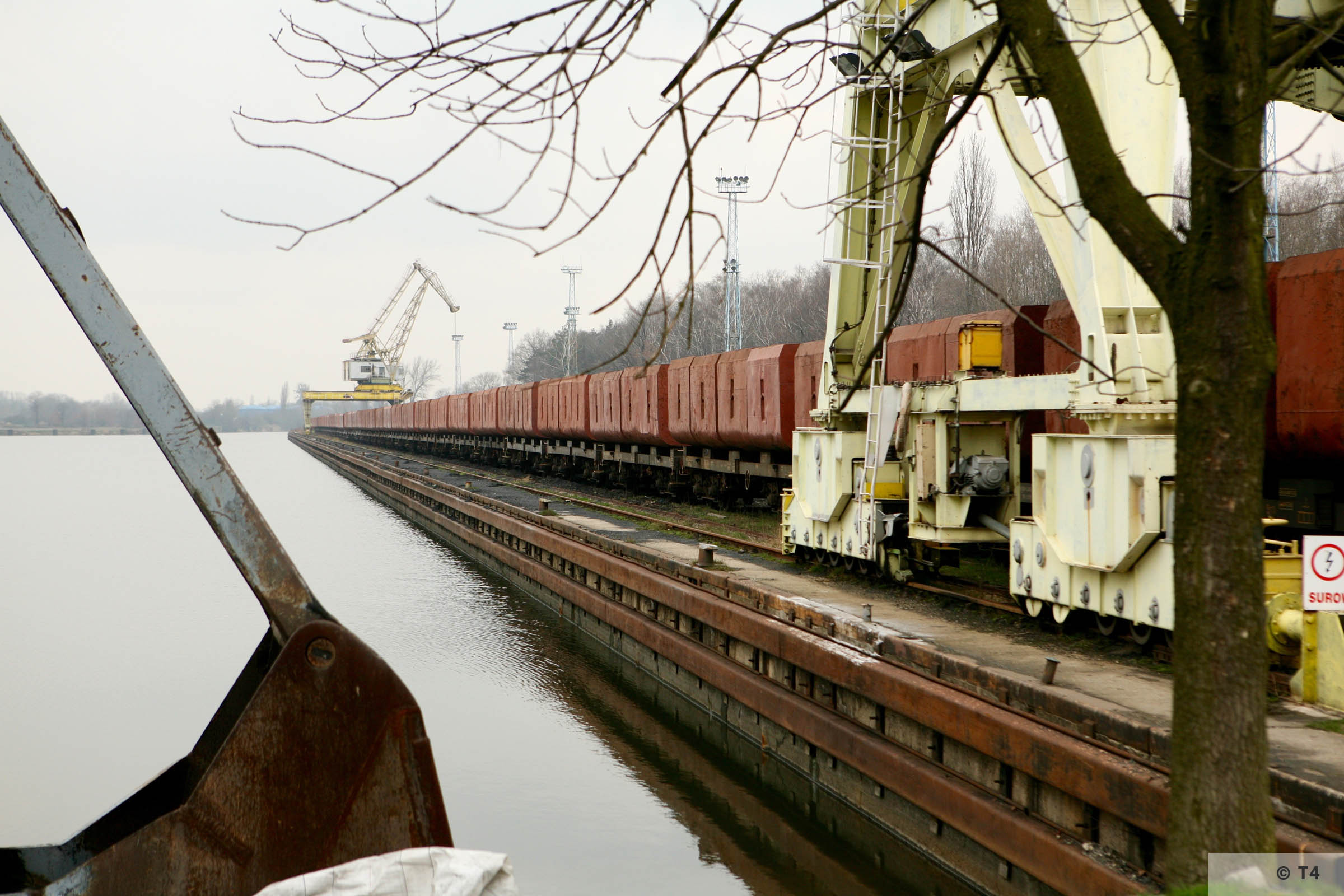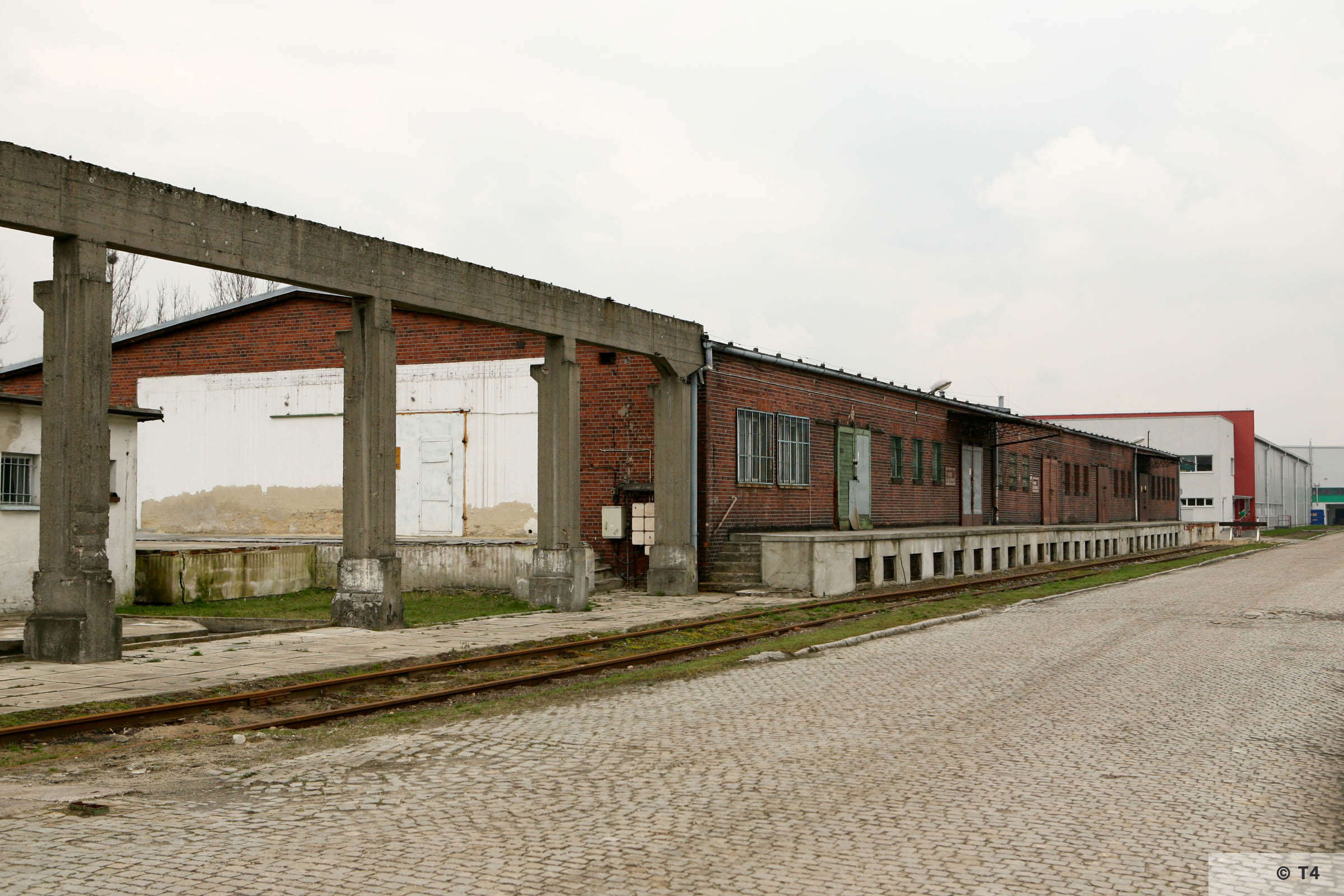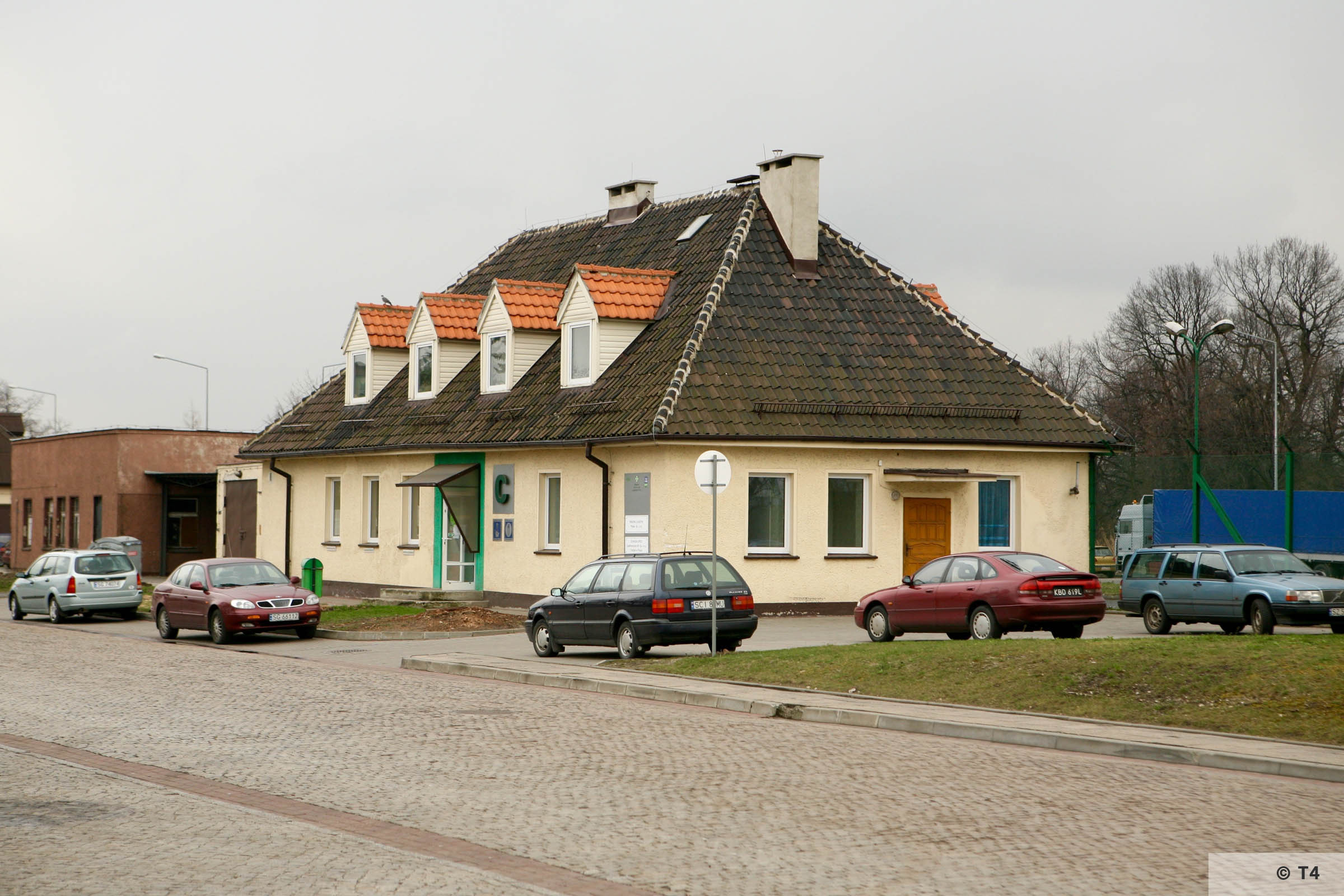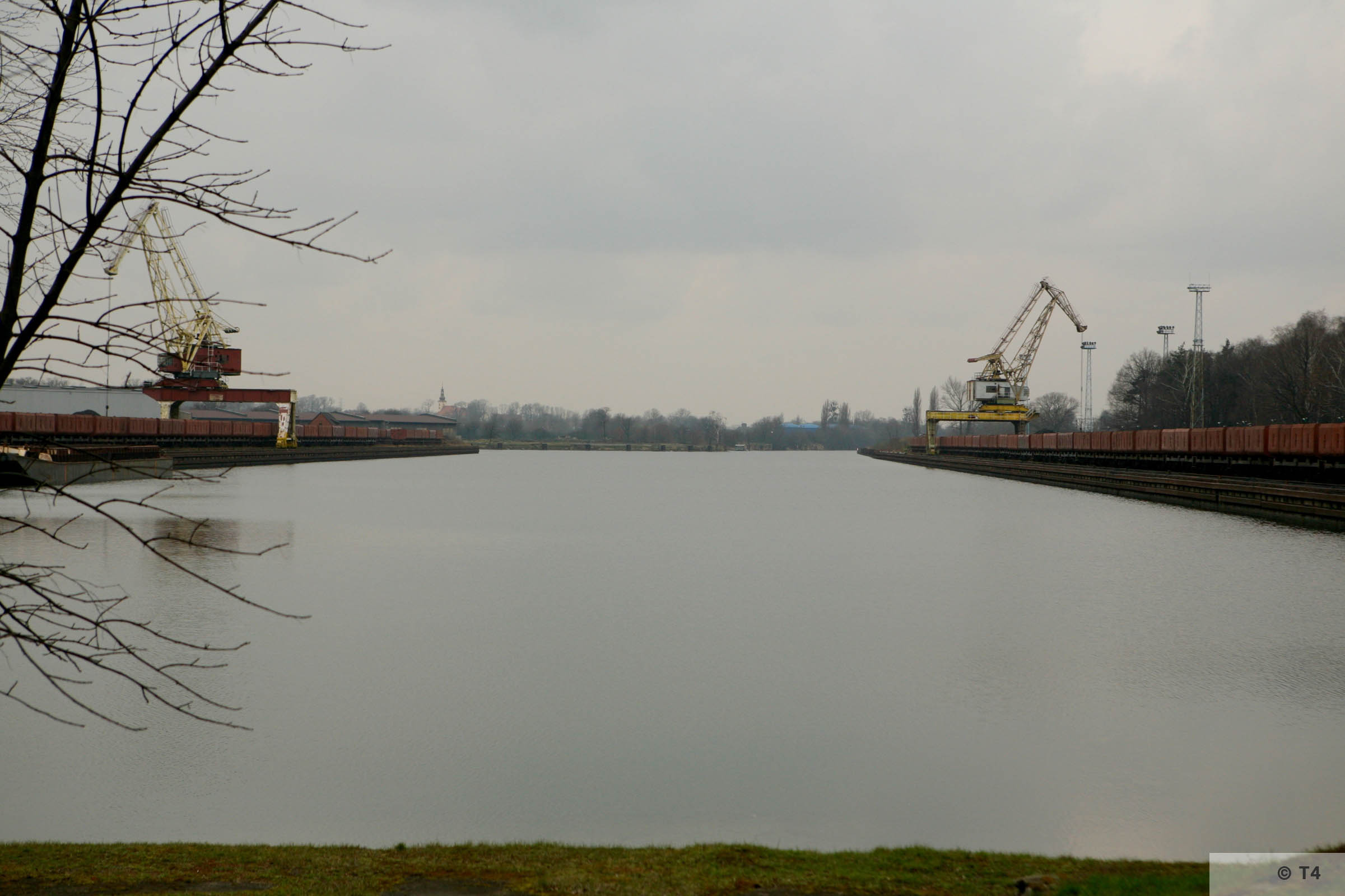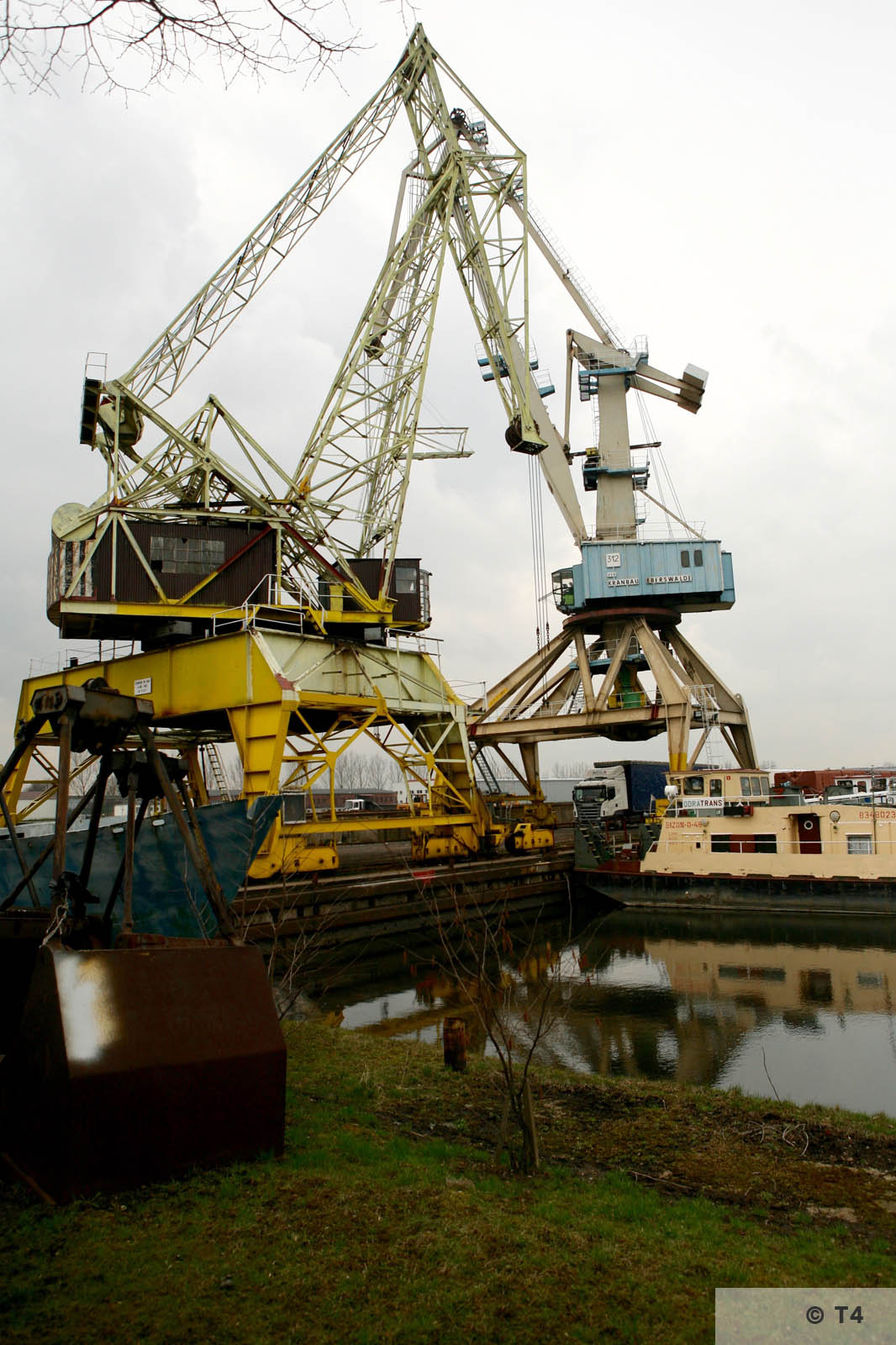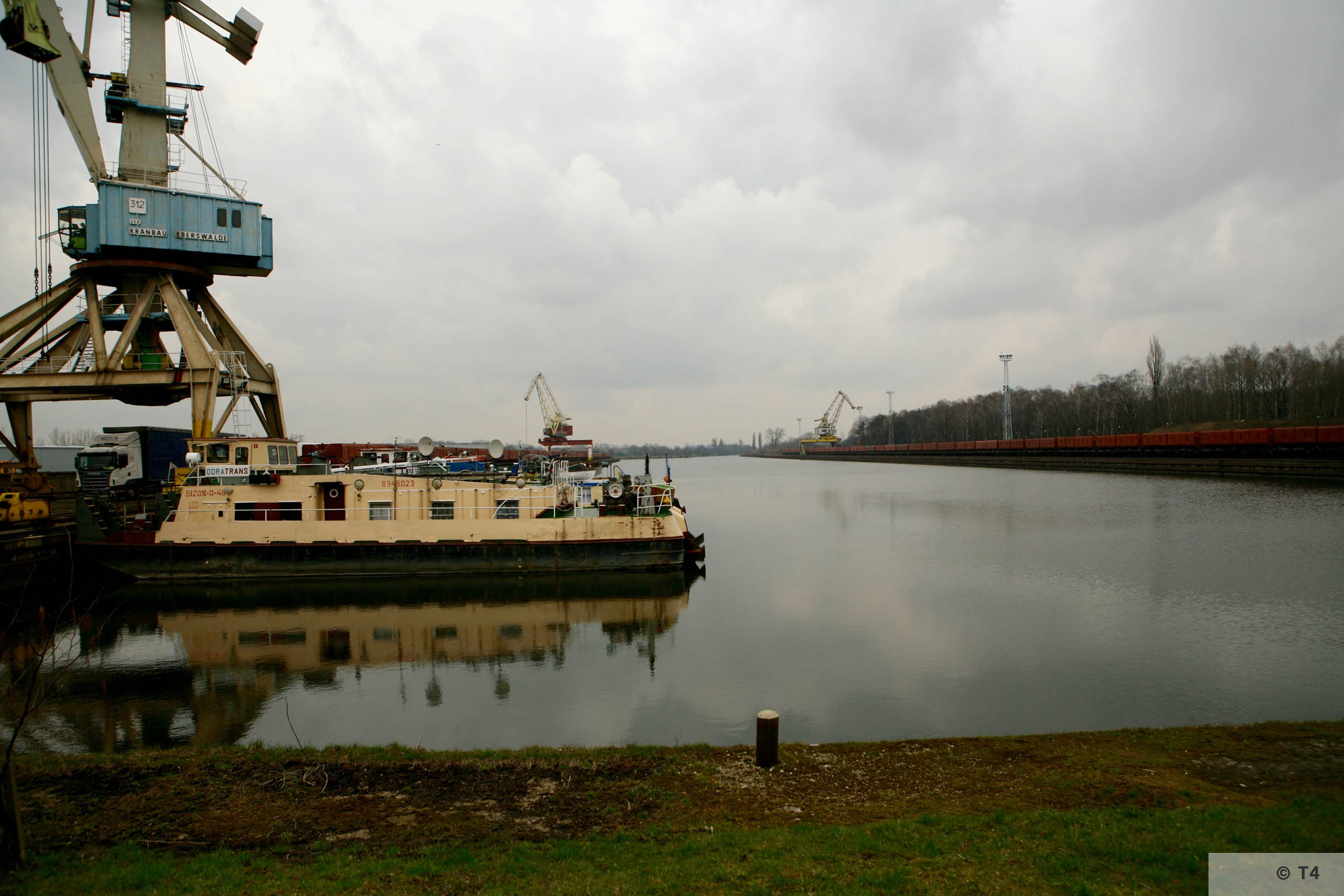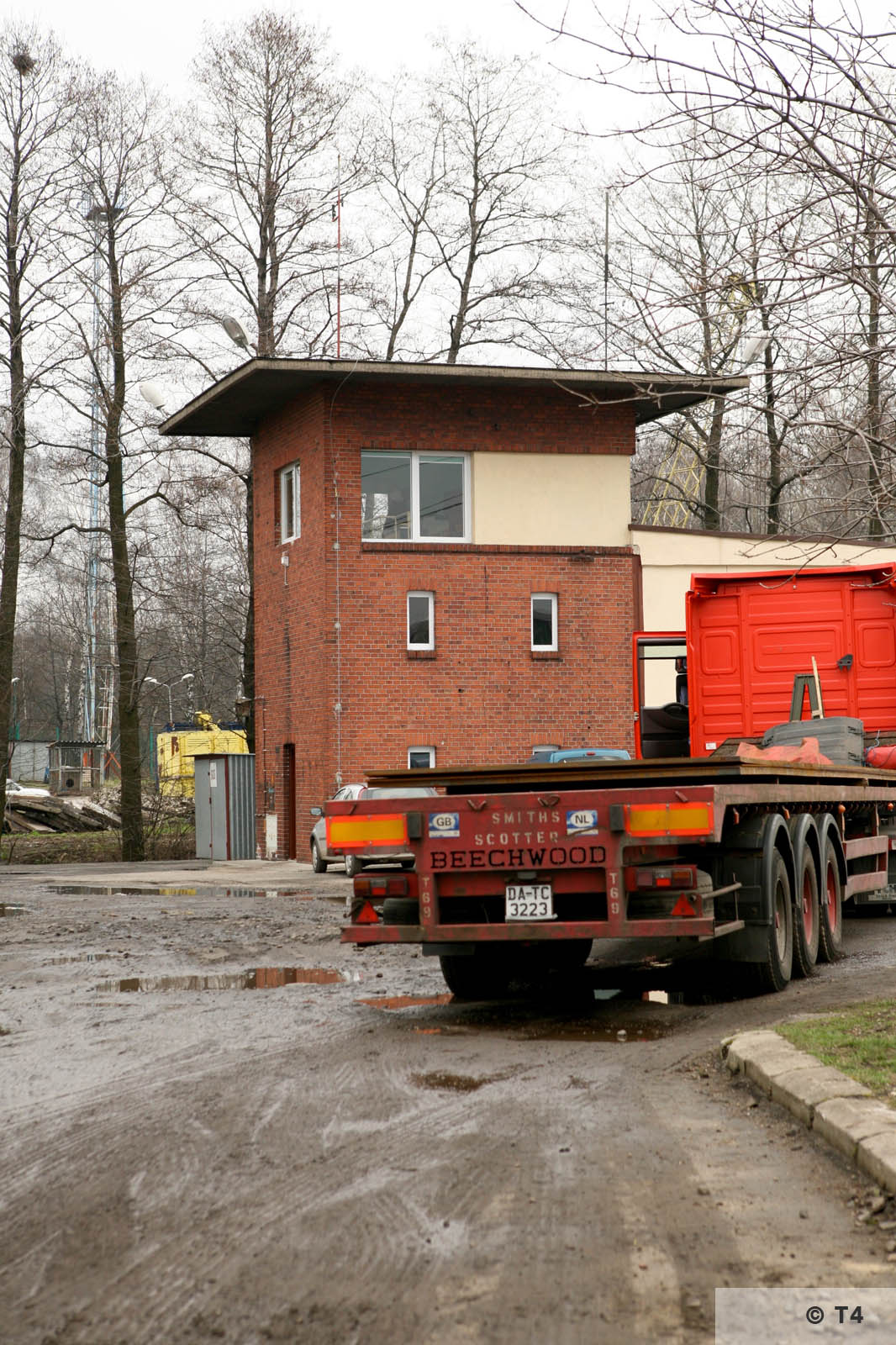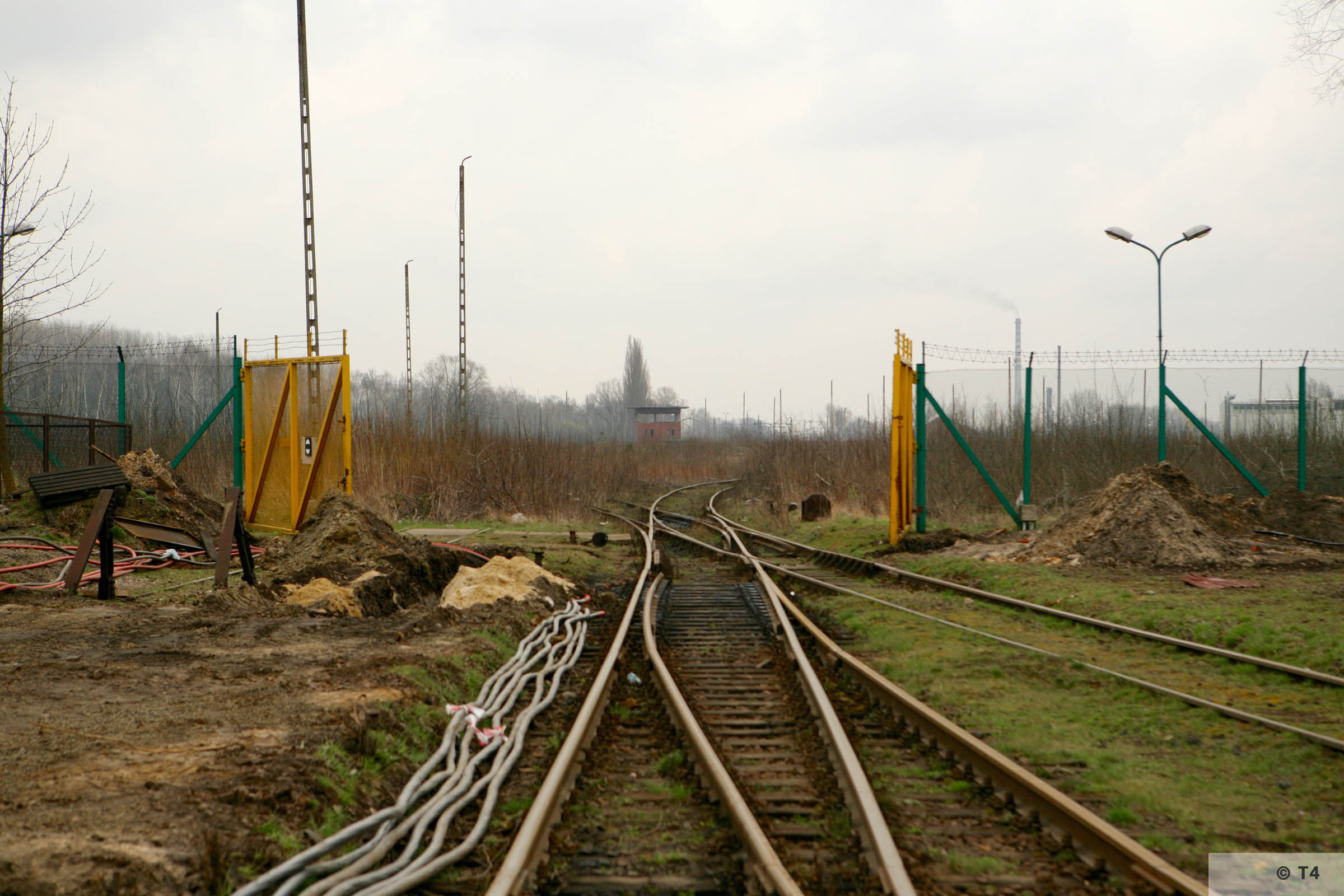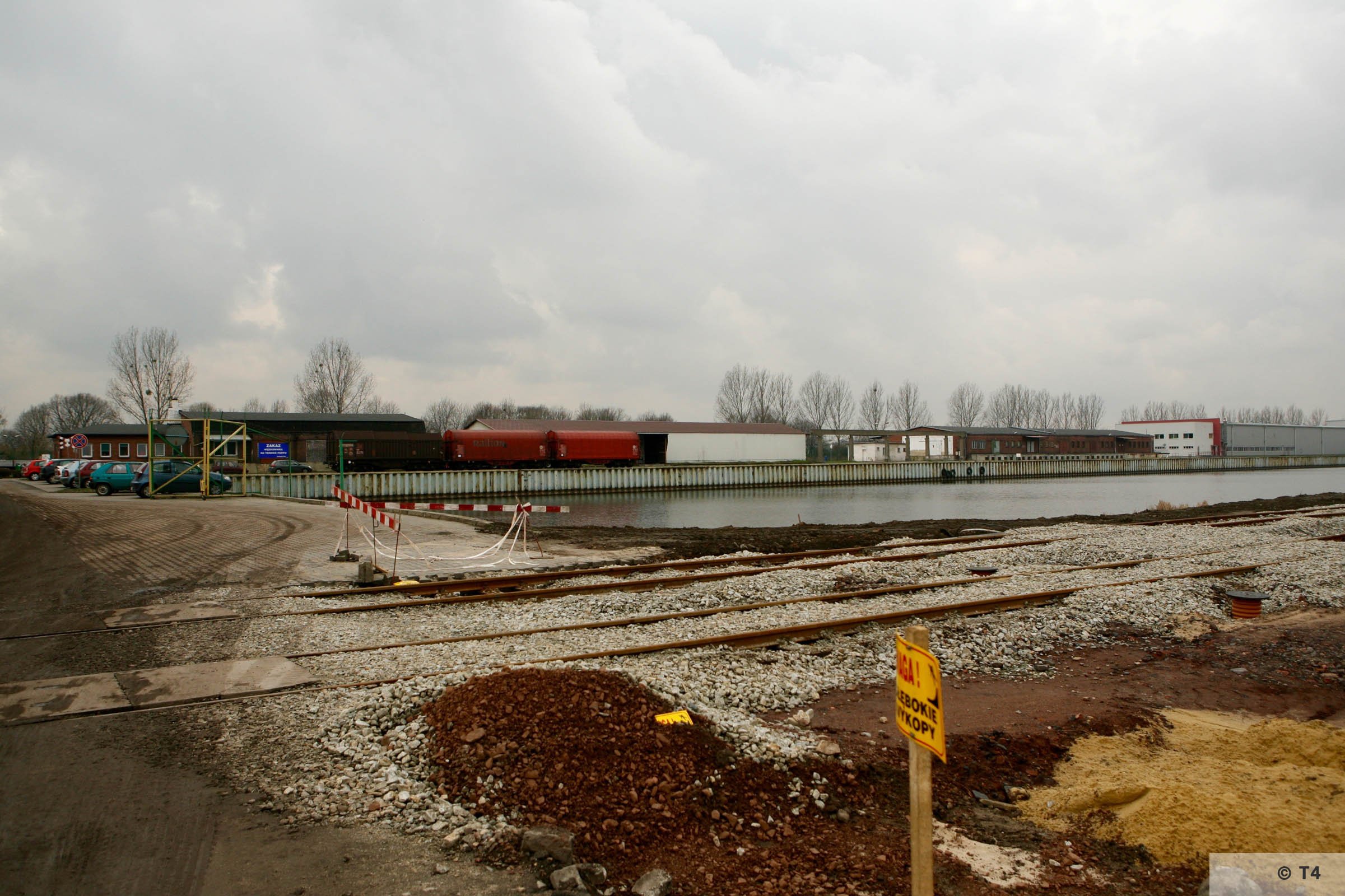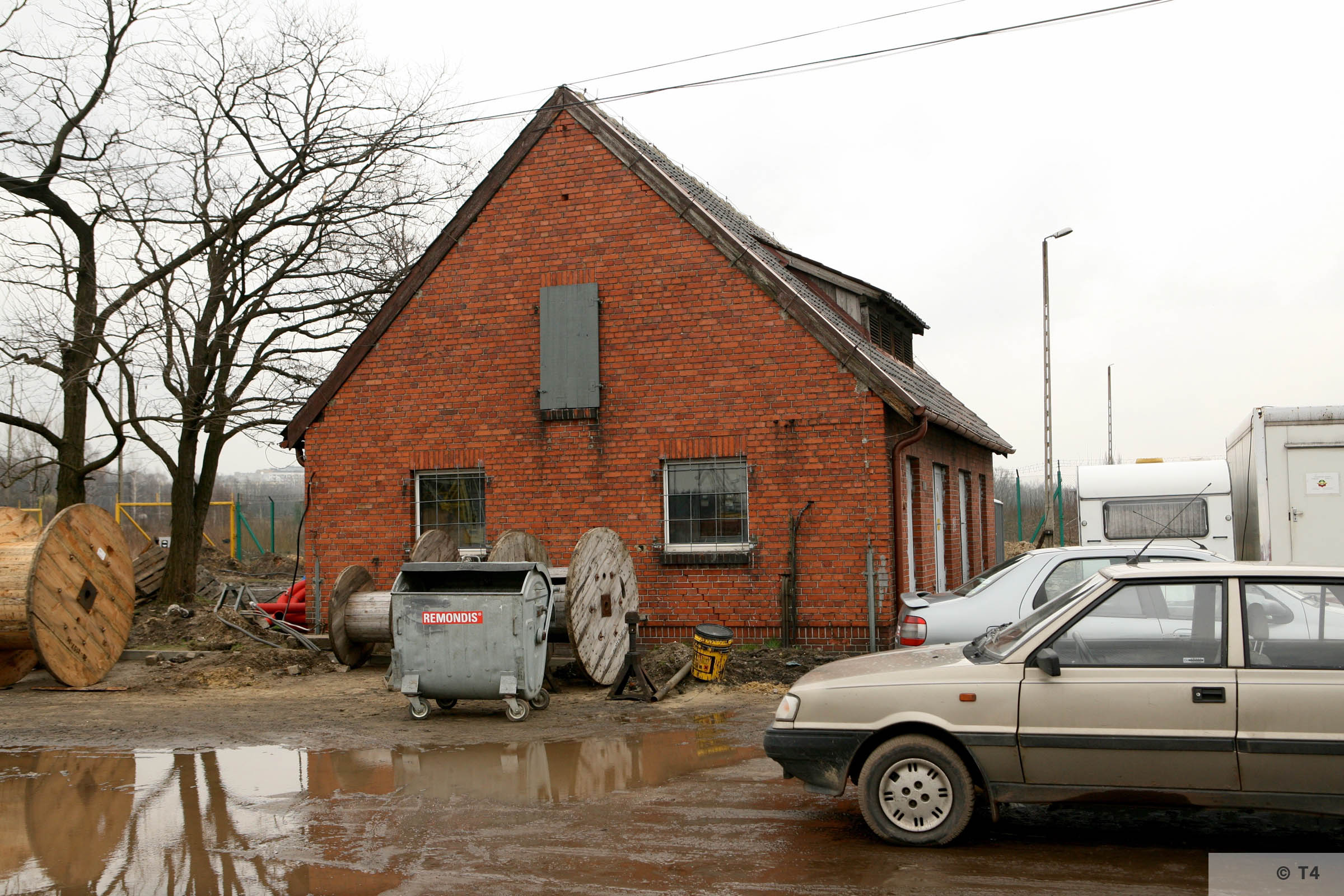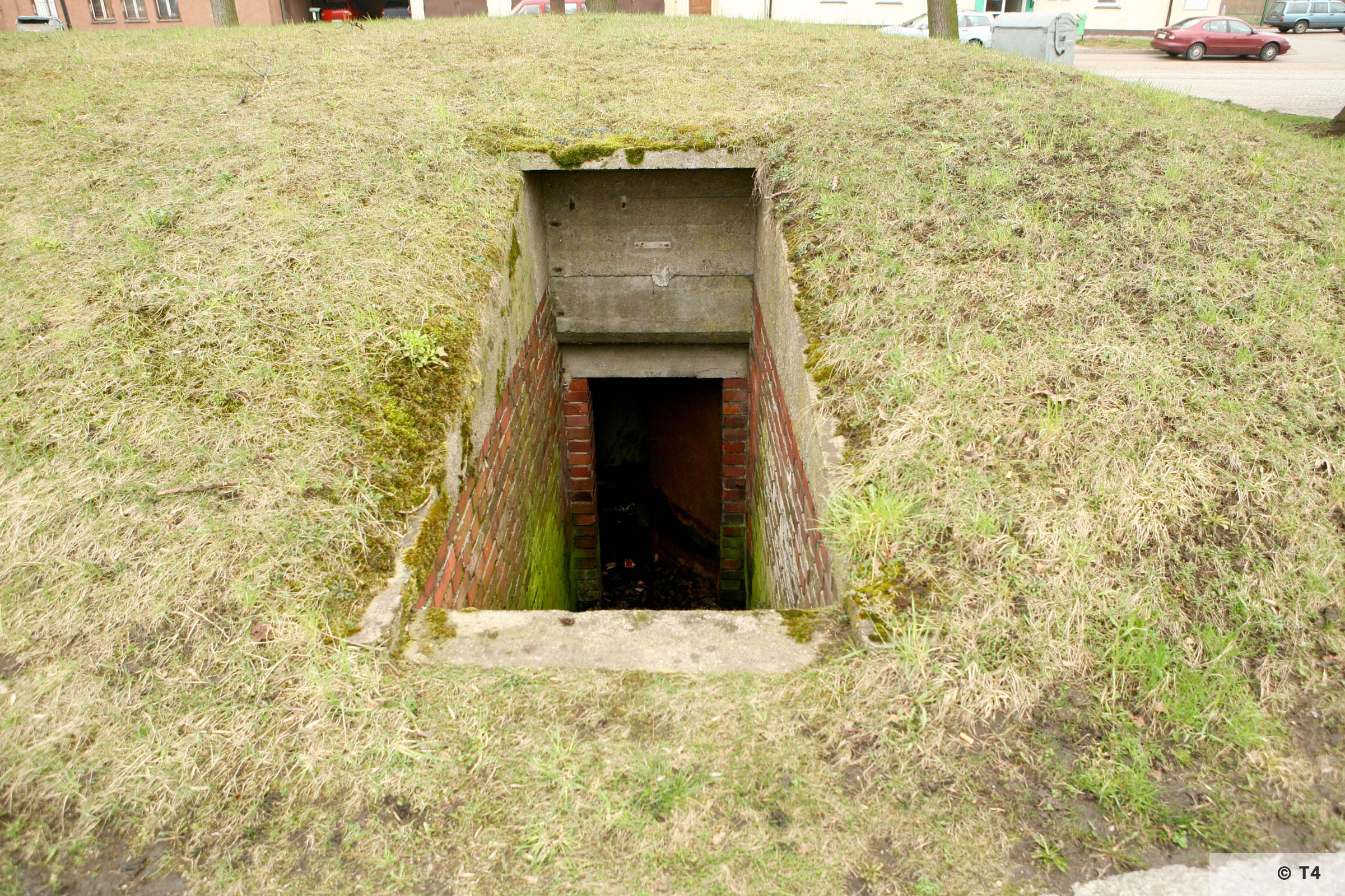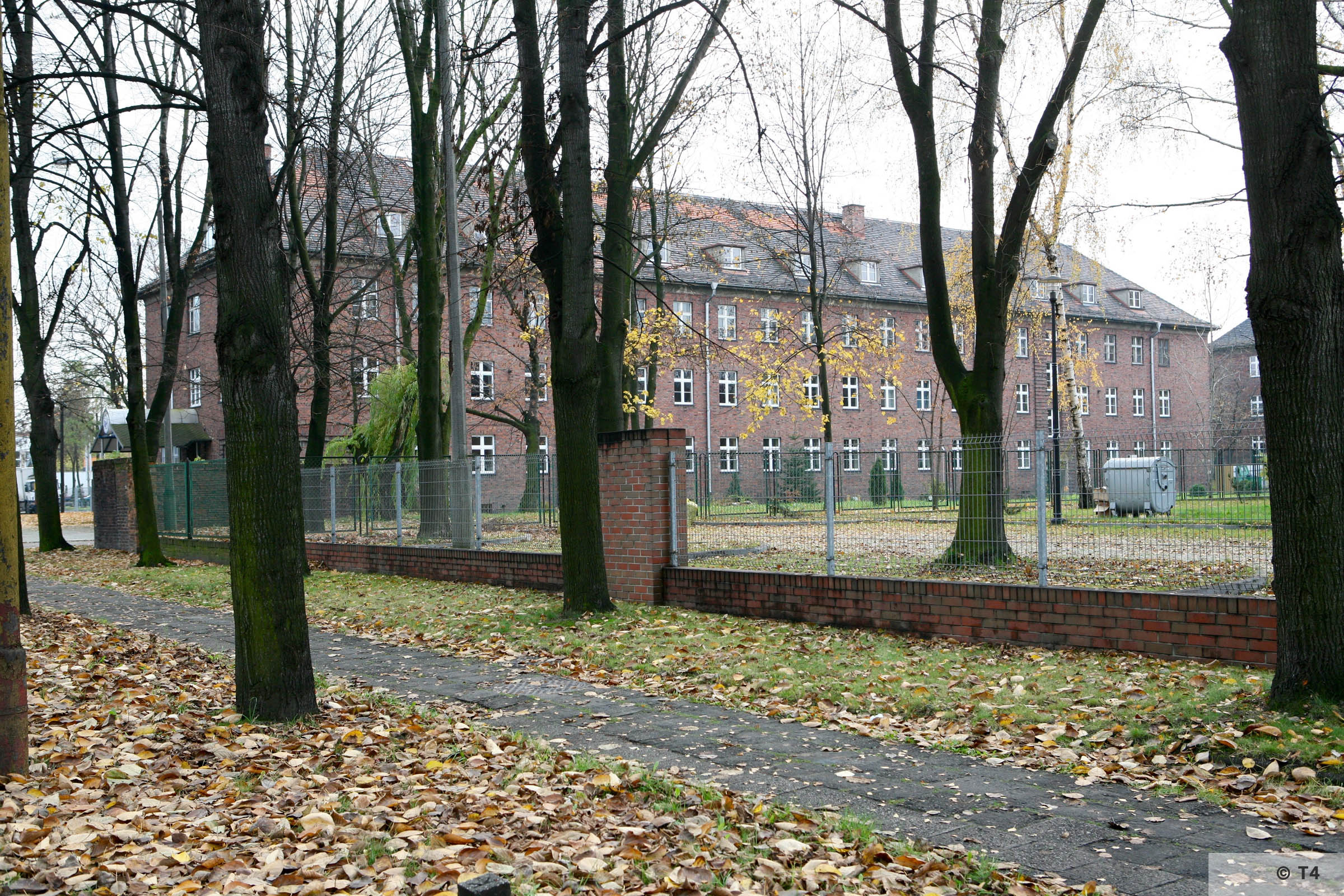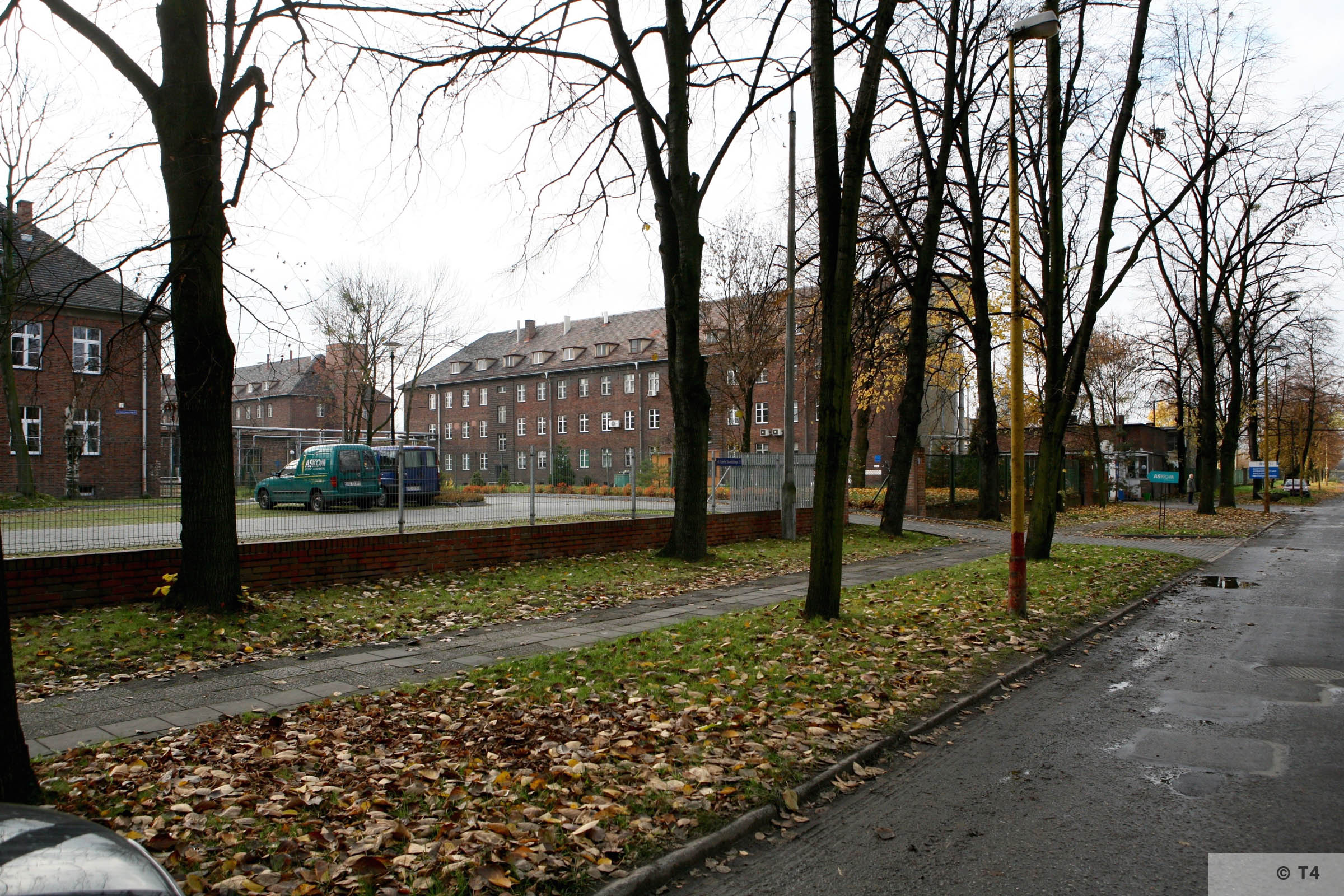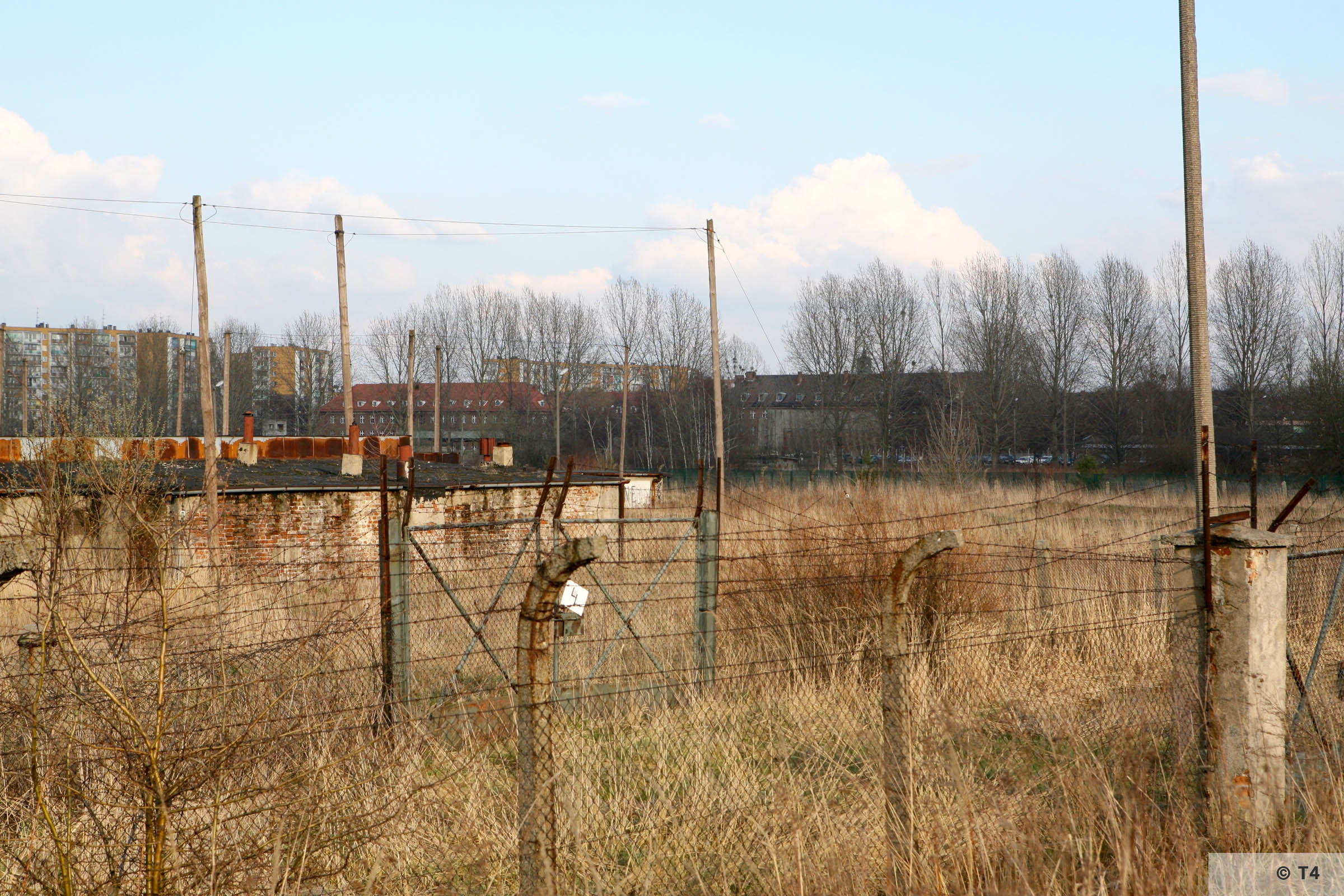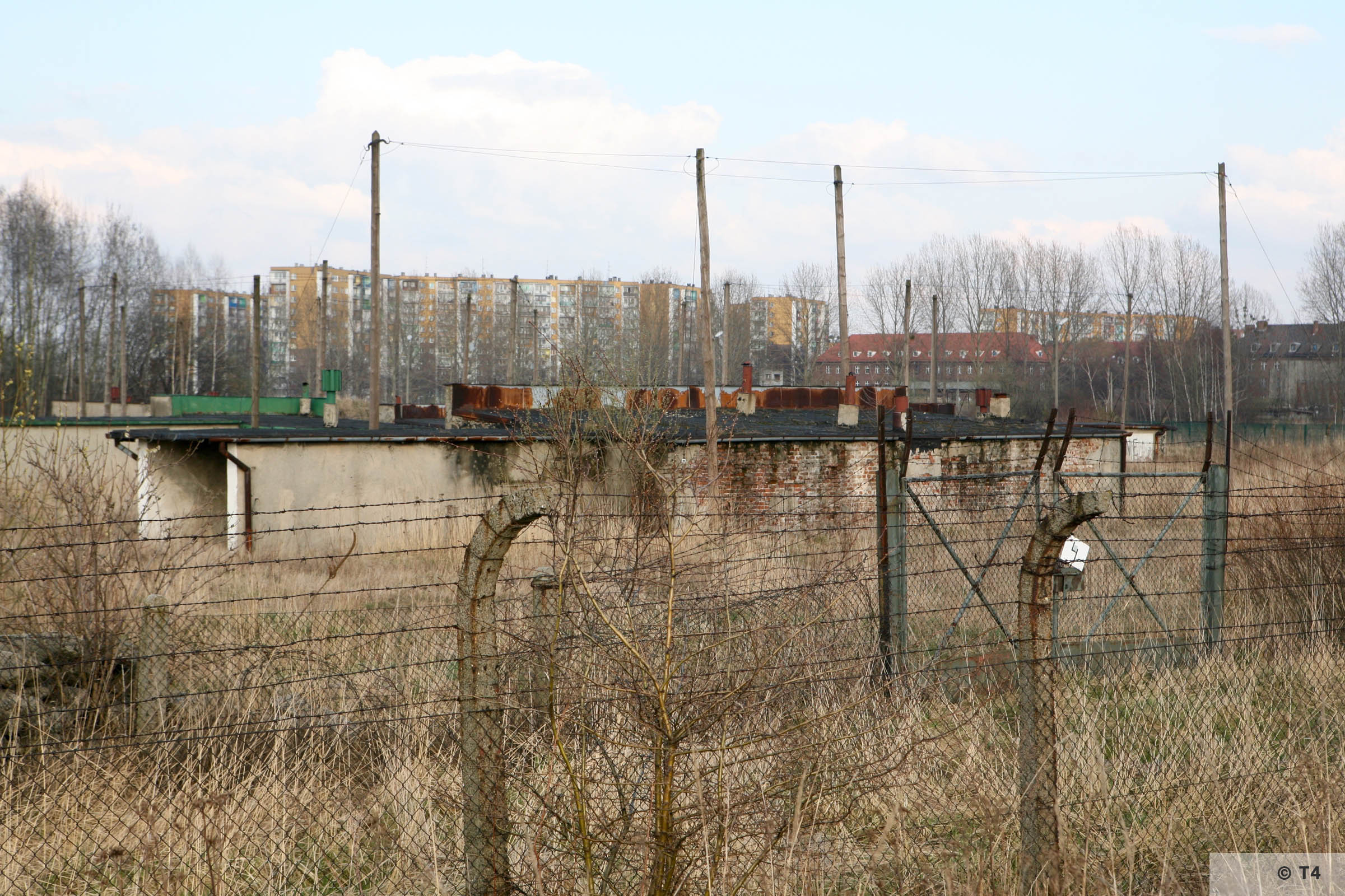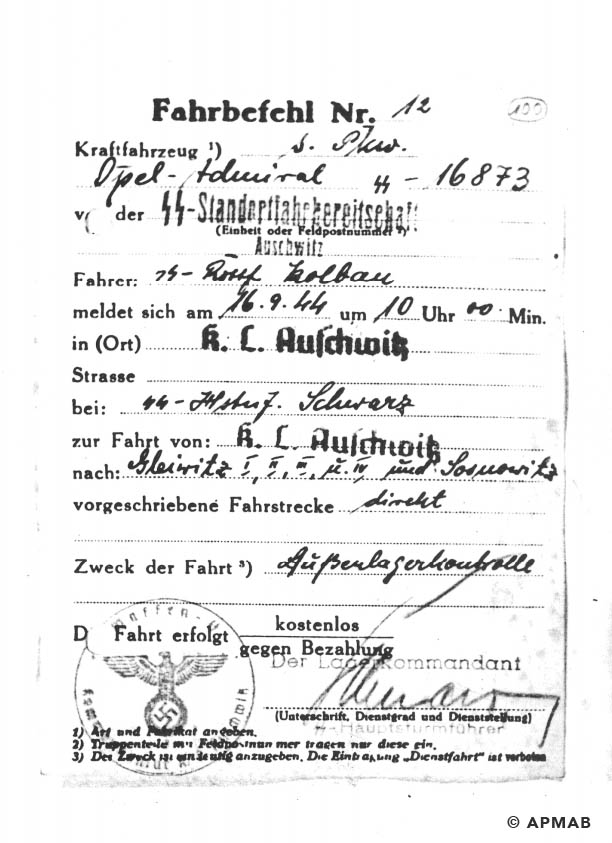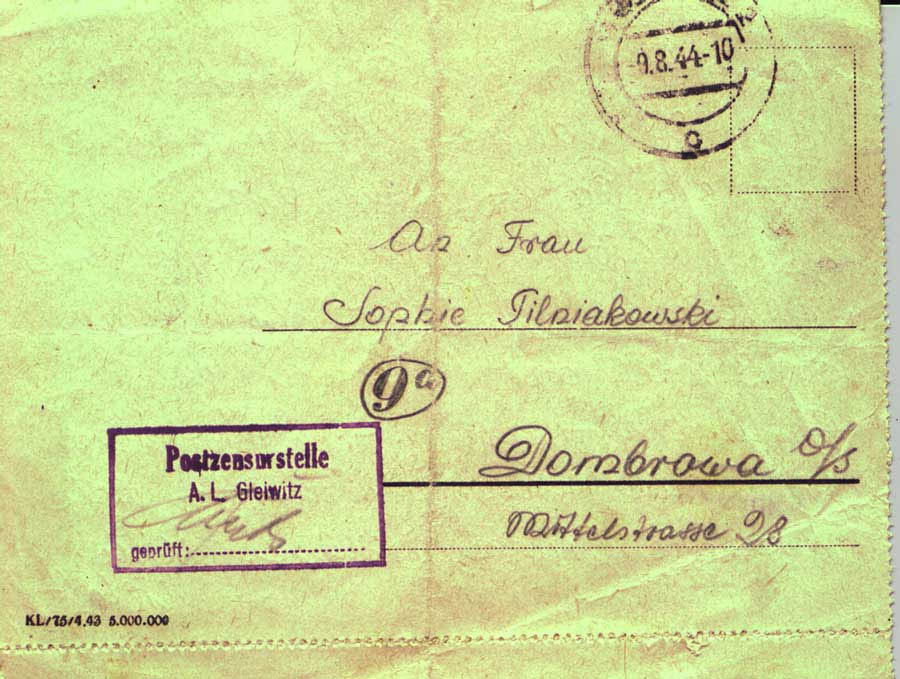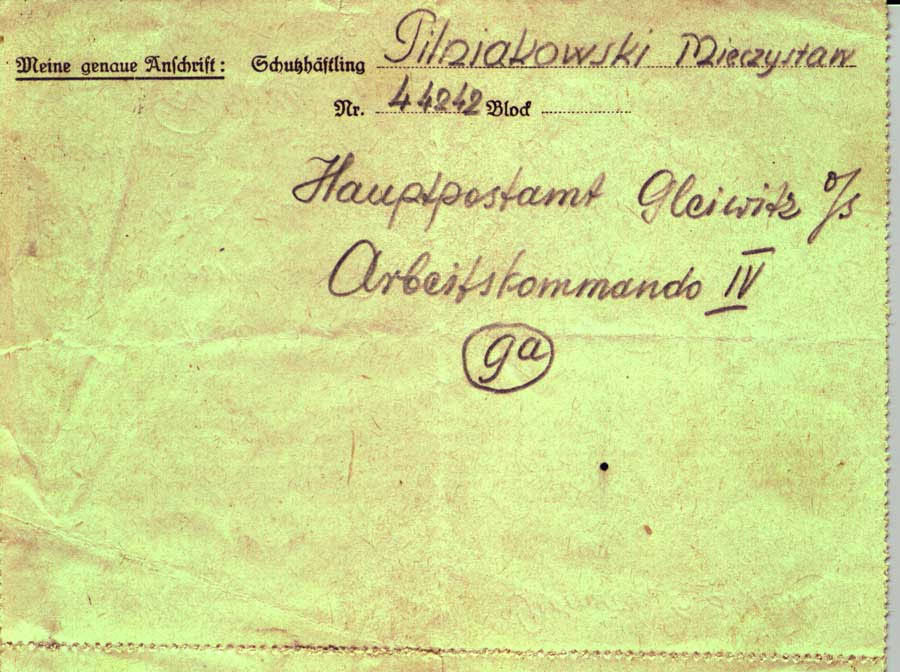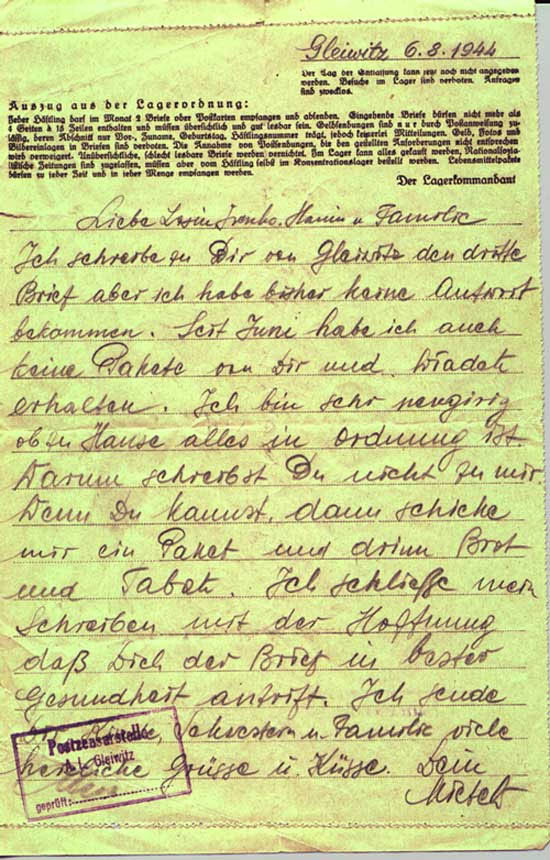Arbeitslager Gleiwitz IV
Commandant of the camp
SS-Oberscharführer Josef Grobert: October 1944 to January 1945
SS-Unterscharführer Otto Arthur Lätsch: June 1944 to October 1944
Number of SS Guards
The guard unit consisted of a total of 60 SS men and former Wehrmacht and Luftwaffe men from the 8th Sentry Company Auschwitz.
Work type
Other: The prisoners of the sub camp Gleiwitz IV were assigned to individual work Kommandos in and around Gliwice. Some of the prisoners worked for Organisation Todt including at the airport and port. They also worked for the company Zieleniewski Maschinen und Waggonbau GmbH converting army truck engines to run on wood gas. In addition after heavy bombing raids on Gliwice in November or December 1944 prisoners worked at clearance of bombed out buildings. Kommando Nr 2 worked in the Keith Kaserne for the Military Administration Gleiwitz constructing buildings and air raid shelters.
Employer
Organisation Todt
Firma Zieleniewski
Military Administration Gleiwitz
Sub camp buildings
Originally founded as a camp for Soviet POWs and forced labourers. Expanded by the sub camp prisoners.
Number of prisoners
444 male prisoners on 17 January 1945. The highest number of prisoners was 800 in August/September 1944.
Nationality of prisoners
Originally 80 Poles, Soviets and subsequently transports of Polish Hungarian and French Jews. Approximately 460 Jews were transported from the Litzmannstadt (Łódź) ghetto via Auschwitz to Gleiwitz IV. In addition, in the sub camp there were prisoners from Hungary, Italy, France, Czechoslovakia and some political prisoners from Germany.
Period of camp existence
June 1944 – 18 January 1945
Dissolution / Evacuation of the sub camp
18/19 January 1945. Prisoners fit to march were evacuated to the town of Sośnicowice. Later they returned to Gliwice. From Gliwice they were transported to the sub camp of Blechhammer. Most of the prisoners were then transported to Gross-Rosen concentration camp and then to Buchenwald concentration camp. Those prisoners unfit to march around 60 and who remained in Gliwice were shot.
Dates of site visits by Tiergartenstrasse4 Association
September 2005, September 2006, March 2007
Memorialisation
On ul Anders in Gliwice outside of the former sub camp area there is a monument erected in 1979 to the prisoners of Gleiwitz IV with a plaque in Polish.
Explore more
The History
The history of the companies and the places prisoners worked, the sub camps, the SS guards and memorialisation of the sites.
The History of the Sub Camp Arbeitslager Gleiwitz IV
In 1943, near the barracks of the Schlegetterkaserne Keith Kaserne in the south-west of Gliwice a camp was founded for Soviet POWs and forced labourers. The camp located in the surrounding fields had an area of approximately 15 hectares. It was fenced in with barbed wire. The prisoners were guarded by soldiers of the Wehrmacht.
The living conditions in the newly built camp were extreme – originally prisoners and labourers were deprived of even a roof over their heads, and some had to sleep in holes dug in the ground. During this period, the prisoners were forced to build wooden barracks, but this did not cover the whole area of the camp. The barracks were built in such a way that the area between them remained open and undeveloped.
In June 1944, about 80 prisoners from Monowitz were brought to the camp and accommodated in one of the barracks, which stood alone from the others. They were mostly Soviets and Poles. Their task was to build a second barrack, and a fence to surround the sub camp. This was the beginning of the new sub camp of Auschwitz in Gliwice, named Arbeitslager Gleiwitz IV. The camp also had the name SS-KZ Lager Gleiwitz IV. This inscription was on the camp bunks.[1] Soon after construction of the two barracks, the 80 prisoners were sent back to Monowitz.[2]
The prisoners of the sub camp Gleiwitz IV were assigned to individual work Kommandos in and around Gliwice. Some of the prisoners worked for Organisation Todt including at the Gliwice airport and canal port. They also worked for the company Zieleniewski Maschinen und Waggonbau GmbH converting army truck engines to run on wood gas. In addition, after heavy bombing raids on Gliwice in November and December 1944 prisoners worked at clearance of bombed out buildings. Kommando numbers 3 and 6 worked in the nearby harbour of the Gliwice canal constructing railway tracks and unloading various materials from trucks for the Holzgaswerke. Kommando Nr 2 worked in the Keith Kaserne for the Military Administration Gleiwitz constructing buildings and air raid shelters.
The first transport to the newly constructed sub camp arrived at the end of August 1944 from Auschwitz II-Birkenau. The founding of the Gleiwitz IV sub camp was remembered by former prisoner Marian Zelman: “We arrived there between 22-24 August, before noon. In these few dozen hectares of empty space, we found only two unprotected barracks, which soon became our accommodation blocks marked with numbers 1 and 2. It turned out that Soviet prisoners of war had lived in those barracks. Immediately after our arrival, the Nazis moved the Soviets to the neighbouring field, where they used them to build new barracks. We were forced by SS men to build a fence around the existing blocks. Construction continued non-stop daily. We raised high concrete posts and stretched barbed wire between them. On the inside of this fence, we arranged a neutral zone, similar to the one established in the Auschwitz main camp. Soon the barbed wire was connected to the mains electricity. We found ourselves in a new sub-camp of Auschwitz, which was named Gleiwitz IV.”[3]
At the end of August and at the beginning of September, subsequent transports of Jews were transferred to the Gleiwitz IV sub camp. The prisoners built a camp kitchen, a food warehouse, a bath with showers and a latrine. Originally meals for the prisoners were prepared in a field kitchen which was subsequently surrounded with walls creating a kitchen hut. [4]
Clothes and provisions for the prisoners were brought from the warehouses in Auschwitz. The food for the prisoners usually consisted of waste products such as potato peelings and was brought in special containers from the town of Gliwice. The diet was so poor that many of the prisoners soon became Muselmänner. [5]
The earliest preserved document from Gleiwitz IV of July 6, 1944 is the order to transfer two prisoners from the hospital in Monowitz to the Gleiwitz sub camp to prepare the infirmary.[6]
In the camp’s infirmary there were usually around 20-30 sick prisoners. Mostly, they were starving prisoners, those suffering from colds, from chronic diarrhoea or those with boils and other wounds that prevented them from freely moving and working. Prisoner doctors – employed in the Krankenbau were not able to help all those who suffered because of the lack of basic dressing materials and medicines. Dr. Miklós Sebestyén from Hungary was the camp physician, and his deputy Dr. Titkin were transported via Auschwitz to the sub camp Gleiwitz IV from the Łódź ghetto.[7]
Every few weeks in the sub camp there were prisoner selections. They were carried out by SS physicians (including SS-Hauptsturmführer Josef Mengele) most often among patients in the infirmary. Selected prisoners were sent by truck to the gas chambers in Auschwitz II-Birkenau, where they were immediately killed. A former prisoner Zenek Baron testified, “In addition, I would like to testify that in 1944, a camp physician (a member of the SS) conducted selections among those prisoners who were unfit for work and who did not look promising. He sent them to the crematorium at the Auschwitz concentration camp. The first group was transported but the second, the one I belonged to, was stopped. Some said that this happened because the ovens were destroyed on account of the Soviets getting closer. This is why I survived. I know that the sick from [illegible] who suffered from dysentery were sent to these ovens earlier.” [8]
The prisoners expecting that they would soon face death at the last moment before being deported, left their personal belongings like knives, spoons, etc to other prisoners.[9]
In September and October 1944, the largest number of prisoners in the sub camp Gleiwitz IV was reached with approximately 800. They were mainly Polish, Hungarian and French Jews. In addition, there were prisoners from Hungary, Italy, France, Czechoslovakia and some political prisoners from Germany. [10] According to former prisoner Izrael Steinfeld approximately 460 Jews from Łódź were sent to the sub camp Gleiwitz IV. [11]
As in many of the sub camps the death rate among the prisoners was catastrophic. Izrael Steinfeld a former prisoner in the Gleiwitz IV sub camp from 17 August 1944 until the closing of the camp in January 1945 testified, “I doubt whether even 150 people from the group of 460 with whom I arrived with at Auschwitz are still alive.”[12]
[1] APMAB. Zespół Oświadczenia, testimony of Marian Zelman, Vol. 56, p. 30.
[2] Strzelecki, Andrzej, Arbeitslager Gleiwitz IV, [in:] Zeszyty Oświęcimskie [1972] Nr 14, p. 139.
[3] APMAB. Zespół Oświadczenia, testimony of Marian Zelman, Vol. 56, p. 29-30.
[4] APMAB. Zespół Oświadczenia, testimony of Marian Zelman, Vol. 56, p. 31.
[5] Strzelecki, Andrzej, Arbeitslager Gleiwitz IV, [in:] Hefte von Auschwitz [1973] Nr 14, p. 161.
[6] They were prisoners: Feliks Walentynowicz (Nr 36) and a Hungarian Jew Nicolaus Sebestyen (Nr A-8605); see: Strzelecki Andrzej, Arbeitslager Gleiwitz IV, [in:] Zeszyty Oświęcimskie [1972] Nr 14, p. 139.
[7] APMAB. Zespół Oświadczenia, testimony of Marian Zelman, Vol. 56, p. 34.
[8] Testimony of former Auschwitz prisoner Zenek Baron https://www.zapisyterroru.pl/dlibra/publication/3952/edition/3932/content.
[9] APMAB. Zespół Oświadczenia, testimony of Marian Zelman, Vol. 56, p. 33.
[10] APMAB. Zespół Oświadczenia, testimony of Marian Zelman, Vol. 56, p. 33.
[11] Testimony of former Auschwitz prisoner Izrael Steinfeld. Viewed 16 August 2019. https://www.zapisyterroru.pl/dlibra/publication/3961/edition/3940/content.
[12] Testimony of former Auschwitz prisoner Izrael Steinfeld. Viewed 16 August 2019. https://www.zapisyterroru.pl/dlibra/publication/3961/edition/3940/content.
Literature:
Strzelecki, Andrzej, Arbeitslager Gleiwitz IV, [in:] Zeszyty Oświęcimskie [1972] Nr 14, p. 137-154.
Strzelecki, Andrzej, Arbeitslager Gleiwitz IV, [in:] Hefte von Auschwitz [1973] Nr 14, p. 151-169.
The SS Guard Unit
The first Lagerführer of Gleiwitz IV was SS-Unterscharführer Otto Arthur Lätsch. Lätsch had been a Blockführer both at Auschwitz I and Auschwitz III-Monowitz. [1]
Lätsch was a brutal man. Izaak Herschenbaum a former prisoner testified “I witnessed him murder a Jewish musician from Łódź. What is more, he would also visit kommandos to see how the prisoners worked. One day, he also came to my kommando. He told me to fill a big wheelbarrow with concrete, and when I couldn’t lift it, he started beating and tormenting me, saying that I didn’t want to work. I explained to him that I wanted to work, but I couldn’t lift the wheelbarrow. Then, he wrote down my number and when I came back from work to the camp, he started tormenting me again, asking why I didn’t want to work. I repeated my explanation that I wasn’t avoiding work, but I was not able to lift the wheelbarrow. He started beating and kicking me so badly that I fell down. I was very weak. Lätsch made us exercise which always ended with a few casualties. They were taken to the Krankenbau (prisoner hospital) where they would usually die.” [2]
In October 1944 Lätsch was demoted but remained on the sub camp SS staff as the Rapportführer. He was succeeded by SS-Oberscharführer Josef Grobert. A description of Grobert’s personality was given by Marian Zelman, a former prisoner: “(…) he had fish like eyes and sharp eyes, he maintained strong discipline in the camp, over both the prisoners and SS men. He was very harsh but in a peculiar way a just way. He wanted to show his superiors the results of the prisoners‘ work. He wanted the prisoners to carry out the construction plans of the companies in which they were employed. Therefore, he wanted the prisoners to leave the camp for work assignments as people capable of working, not battered and beaten. In comparison, Grübner finished off those prisoners who were not fit for work. The SS guards, on the other hand behind the Lagerführer’s back, treated the prisoners as brutally as possible.”[3]
The former prisoner Jozek Stern also remembered Lätsch, “On 17 August 1944, I arrived at Gliwice, where defendant Lätsch held the position of Lagerführer. He treated us very brutally. We could never understand a word of what he said. He would just kick and hit us with a stick on the head and face. He stayed in the camp for several weeks and carried out unauthorized selections. He sent several dozen people, including my brother and brother-in-law, to the crematorium. A few days later, the defendant started coming to check on the work. When he came, SS men who were his subordinates would give us a sign to work hard, because otherwise we would be duly punished. One Saturday after work, he told us that the following day we would not go to work, and there would be a roll call instead. It was a roll call devoted to cleanliness. The defendant selected a person whom he considered dirty, took him behind the barbed wire gate, and shot him there. Then, he came back to the square and asked who used to sleep in the same bed with the man who had just been shot. The man’s brother, not having realized what had just happened, came forward, thinking that he must be as dirty as his brother. He was dragged out from the column and the scene repeated. It happened in front of all prisoners. Afterwards, selections were also carried out and each time several dozen people were sent to the crematorium….. One day, an order was given to shave our heads with a razorblade. They shaved us until we bled. The following day, the defendant came to us and hit us with a cane on the head, saying, “you dogs, your hair is too long.” Eventually, I was transported out of the camp.” [4]
Former prisoner Mojzesz Zawadzki remembered Lätsch “At some point in August 1944 I was sent with a transport of Häftlings from Auschwitz to the concentration camp Gleiwitz IV. At that time, Otto Lätsch was Lagerführer there. During my stay at that camp, he held this post until October 1944 and was then replaced by another German, whose name I can’t remember. Lätsch became Rapportführer. Otto Lätsch can be described as an absolute beast, who only waited for an opportunity to abuse someone. He beat and kicked people all over the body every day. He would sometimes kick in the face with his boot a beaten up prisoner lying on the ground. On top of that, he beat people with a rubber Knüppel (baton). He kicked me in the stomach when I worked as an installation electrician in his private apartment. He kicked me for failing to immediately understand an order that he gave me during work. At the end of 1944, I saw Lätsch shoot a Polish Jew, a Häftling named Strasberg. I was in the sick room that day and observed the whole incident through a window. Strasberg was pushing a cart with trash and another Häftling, a French man, was pulling it. The person who walked behind him that day was not a guard, but Lätsch himself. When they were several steps outside the gate, Lätsch drew his gun and shot Strasberg in the back of the head, killing him on the spot. Two people from the sick room had to carry the corpse to a special ditch. Lätsch hid this murder by reporting to Lagerführer that Strasberg tried to escape. I firmly declare that Strasberg was not trying to escape, he was pushing the cart the entire time.” [5]
SS-Unterscharführer Otto Lätsch was captured by the Allies and handed over to the Polish authorities to be tried in the Auschwitz trial in Krakow. Otto Lätsch was sentenced to death by hanging on December 22, 1947 by the Supreme National Court in Krakow. The sentence was carried out in Montelupich prison in Krakow.[6]
The sub camp guard unit consisted of 60 SS men, and from August 1944 50 SS men. Many of the SS guards were former Wehrmacht soldiers who continued to wear their army uniforms but with SS patches. [7]
The Lagerälteste was a man named Paul. The Blockältesten were Bruno Neumann and man named Willi. The Kapos: Marer (or Mehrer or Mare), Gedalier Fuchs and Pilichowski. [8]
The prisoners at work were overseen by members of Organisation Todt. [9]
[1] Testimony of former Auschwitz prisoner Janusz Hrynkiewicz. Viewed 16 August 2019. https://www.zapisyterroru.pl/dlibra/publication/3952/edition/3932/content.
[2] Testimony of former Auschwitz prisoner Izaak Herschenbaum. Viewed 16 August 2019. https://www.zapisyterroru.pl/dlibra/publication/3952/edition/3932/content.
[3] APMAB. Zespół Oświadczenia, testimony of Marian Zelman, Vol. 56, p. 36.
[4] Testimony of former Auschwitz prisoner Jozek Stern. Viewed 16 August 2019. https://www.zapisyterroru.pl/dlibra/publication/3952/edition/3932/content.
[5] Testimony of former Auschwitz prisoner Mojzesz Zawadzki. Viewed 16 August 2019. https://www.zapisyterroru.pl/dlibra/publication/3952/edition/3932/content.
[6] Langbein, Hermann. Der Auschwitz Prozess: Ein Dokumentation. Neue Kritik 1. März 1995.
[7] Strzelecki, Andrzej, Arbeitslager Gleiwitz IV, [in:] Hefte von Auschwitz [1973] Nr 14, p. 156.
[8] Strzelecki, Andrzej, Arbeitslager Gleiwitz IV, [in:] Hefte von Auschwitz [1973] Nr 14, p. 159.
[9] Strzelecki, Andrzej, Arbeitslager Gleiwitz IV, [in:] Hefte von Auschwitz [1973] Nr 14, p. 165.
Literature:
Strzelecki, Andrzej, Arbeitslager Gleiwitz IV, [in:] Zeszyty Oświęcimskie [1972] Nr 14, p. 137-154.
Strzelecki, Andrzej, Arbeitslager Gleiwitz IV, [in:] Hefte von Auschwitz [1973] Nr 14, p. 151-169.
The SS Guards
References:
Rudorff, Andrea, Gleiwitz IV (Gliwice) in Des Ort des Terrors Band 5, Geschichte der Nationalsozialistischen Konzentrationslager. C.H.Beck 2007, p. 238-239.
BA Ludwigsburg B162/2680 and B162/2679. For the four Gleiwitz sub camps in most cases the listing of SS personnel does not specify which of the four camps SS guards were assigned to.
Zppw-auschwitz.pl Zwiazek Polaków Pomordowanych w Auschwitz. List of 8,500 SS men in KL Auschwitz.
IPN database of Auschwitz SS guards. https://truthaboutcamps.eu/th/form/60,Zaloga-SS-KL-Auschwitz.html.
Strzelecki, Andrzej, Arbeitslager Gleiwitz IV, [in:] Zeszyty Oświęcimskie [1972] Nr 14, p. 137-154.
Strzelecki, Andrzej, Arbeitslager Gleiwitz IV, [in:] Hefte von Auschwitz [1973] Nr 14, p. 151-169.
The Evacuation of the Sub Camp Arbeitslager Gleiwitz IV
The evacuation of the Gleiwitz IV sub camp commenced on the night of 18 to 19 January 1945. A group of around 380 prisoners were led out of the barracks and escorted to the town of Sośnicowice. In the sub camp there remained a group (around 60 prisoners) too sick or unable to march who remained in the camp infirmary.
Soon after the column had left SS-Unterscharführer Otto Lätsch and one of the Organisation Todt men [1] Gustaw Günther together with a group of several other Nazis set fire to the infirmary with the sick prisoners inside. These dramatic events were recounted by one of the inhabitants of Gliwice: “On the eve of the liberation of Gliwice [2], around 11.30-12.00 pm, the inhabitants of Stare Gliwice [3] awoke to see a glow hovering over the camps. People ran out of their houses. Together with my peers – not taking into account the danger from the Nazis – I ran through the snow-covered fields and approached within 300 m of the camp where prisoners in striped uniforms were living. Against the background of a burning barrack, from which billows of black smoke were rising (the fire looked as if the barrack was being doused with some flammable liquid), we saw the silhouette of the watchtower and the guard standing on it. We heard single and multiple shots. We saw black silhouettes of people jumping out of the windows of a burning barrack. I suppose that was what the guard on the tower was shooting at. At some point, he noticed us and directed a series of shots towards us. Fortunately, none of us were hurt. We hid in a ditch in a field and continued to watch the barrack burning in the camp. Several people jumped out of the windows of the burning barrack. After some time, we withdrew and returned home.”[4]
Meanwhile, the evacuation column of prisoners from the Gleiwitz IV sub camp who had headed in the direction of Sośnicowice returned to Gliwice. The evacuees were then directed to the Auschwitz sub camp Blechhammer near Kędzierzyn Koźle. During the three-days on the road, SS men shot about 50 prisoners who could not keep up.
A former prisoner Zenek Baron testified after the war, “On 19 January 1945, the camp was evacuated to the west. About 50 prisoners unfit for marching stayed behind in the sick room. The sick room was burnt three days later, and these ill people burnt along with it. I don’t know who gave the order. I learned about this from one Dąbrowski (father) and another former Häftling. They were the only people from the group of sick prisoners who survived. They told me about this incident when I saw them in the spring of 1945 in Łódź. They survived because they managed to jump from a window of the burning building and hide among the corpses of those who were shot when they were jumping out. On the first day of the march, about 20 kilometres from Gliwice, I saw Lätsch shoot a prisoner who couldn’t walk any longer. I didn’t see Lätsch shoot anyone else. Considering all the crimes and atrocities committed by Lätsch, the fact that he gave orders to beat and torment us during the march isn’t really worth mentioning. After two days of marching, we got to Blechhammer. On the second day of the march, I saw Lätsch for the last time around noon. I don’t know if he left the column. I suspect that three hours before we got to Blechhammer, he drove ahead by car. I never saw him in Blechhammer, but I did see the car in which he had driven with the Lagerführer. [5]
Just before arriving in Blechhammer, the head of the sub camp SS-Oberscharführer Grobert and SS-Unterscharführer Otto Lätsch separated from the evacuation column and drove away in the direction of Nysa. [6]
In the growing chaos, some of the prisoners managed to escape from Blechhammer. Others mixed together with the prisoners already there from other sub camps and were transported to the Gross-Rosen concentration camp and onwards to the Buchenwald concentration camp. A small group of Gleiwitz IV prisoners survived until liberation in Blechhammer. [7]
[1] Testimony of former Auschwitz prisoner Mojzesz Zawadzki. Viewed 16 August 2019. https://www.zapisyterroru.pl/dlibra/publication/3952/edition/3932/content.
[2] These events took place on the night of 18 to 19 January 1945, while the Red Army entered the city on the night of the 23 to 24 January 1945.
[3] Stare Gliwice (German Alt-Gleiwitz) – district of Gliwice city.
[4] APMAB. Zespół Oświadczenia, testimony of Eugeniusz Franik, Vol. 56, p. 65.
[5] Testimony of former Auschwitz prisoner Zenek Baron. https://www.zapisyterroru.pl/dlibra/publication/3952/edition/3932/content.
[6] Strzelecki, Andrzej, Arbeitslager Gleiwitz IV, [in:] Zeszyty Oświęcimskie [1972] Nr 14, p. 154.
[7] Strzelecki, Andrzej, Arbeitslager Gleiwitz IV, [in:] Zeszyty Oświęcimskie [1972] Nr 14, p. 154.
Literature:
Strzelecki, Andrzej, Arbeitslager Gleiwitz IV, [in:] Zeszyty Oświęcimskie [1972] Nr 14, p. 137-154.
Strzelecki, Andrzej, Arbeitslager Gleiwitz IV, [in:] Hefte von Auschwitz [1973] Nr 14, p. 151-169.
The Post War History of the Former Sub Camp Arbeitslager Gleiwitz IV
The Auschwitz-Birkenau State Museum visited the site of the former Gleiwitz IV sub camp on 3rd May 1962 by which time the former sub camp had been completely destroyed. The sub camp consisted mainly of wooden barracks that were probably dismantled immediately after the war for use as emergency housing.
The Preservation Status of the Former Sub Camp Arbeitslager Gleiwitz IV
Due to the negligible surviving remnants of the sub camp, finding the exact location of the sub camp proved difficult. It is not even certain whether any of the surviving remnants are from the Gleiwitz IV sub camp. Today, there are allotments on the site of the former camp and other camps of the time. The easiest way to get there is from ul Sowińskiego.
There is an original gate, which may be a remnant of one of the camps that were in this area. In addition, there are numerous concrete fence posts in the allotment gardens which may be in their original places or have been moved and reused. No other remnants of the camp were found.
Tiergartenstrasse4Association also visited the sites of the former workplaces of the sub camp prisoners including the airport, canal, former Keith Kaserne which all exist in substantially their original conditions. This is also true for the former Holzgas factory and bunkers.
Memorialisation
On ul Anders in Gliwice, near the roundabout, there is a monument with a plaque in Polish: “Na tym terenie w latach drugiej wojny światowej istniał hitlerowski obóz – filia obozu koncentracyjnego KL Auschwitz-Birkenau. Pamięci ofiar nazizmu. Towarzystwo Opieki nad Majdankiem. Towarzystwo Przyjaciół Gliwic. Gliwice 1979.” (In this area, in the years of the Second World War, there was a Nazi camp – a branch of the KL Auschwitz-Birkenau concentration camp. To the memory of Nazi victims. Society for the Care of Majdanek. Society of Friends of Gliwice. Gliwice 1979.) Next to the monument there is a small information board describing the history of the camp. As in many other sub camps, the memorial is not located in the area where the sub camp existed.
Near the monument commemorating the prisoners of the Gleiwitz IV sub camp at the Central Cemetery at ul Kozielska in Gliwice is a mass grave, in which many corpses of prisoners evacuated from the Gleiwitz sub camps and shot during the march through Gliwice were buried. On the tombstone there is a plaque with the inscription in Polish: “W HOŁDZIE OFIAROM FASZYSTOWSKIEGO BARBARZYŃSTWA DLA PAMIĘCI POKOLEŃ / MIESZKAŃCY GLIWIC / TRZZ / 1 XI 1970”. (“In Tribute to the victims of the fascist barbarism for the memory of generations / inhabitants of GLIWICE / TRZZ / 1 November 1970”).
Auschwitz-Birkenau State Museum Site Visit
The Auschwitz-Birkenau State Museum visited the site of the former Gleiwitz IV sub camp on 3rd May 1962 and took 6 photographs. At this time the former sub camp had been completely destroyed. The sub camp consisted mainly of wooden barracks which were probably dismantled immediately after the war for use as emergency housing. There were only a few fragments of the former sub camp:
- “Fire basin on the camp’s area.” (photograph reference 914),
- “Buildings built by prisoners.” (this is the nearby former Keith Kaserne.) (photograph reference 912),
- “Concrete floor.” (photograph reference 915),
- “Foreground – two concrete columns of main gate; background – concrete bunker – most probably fragment of watch tower.” (photograph reference 926).



